


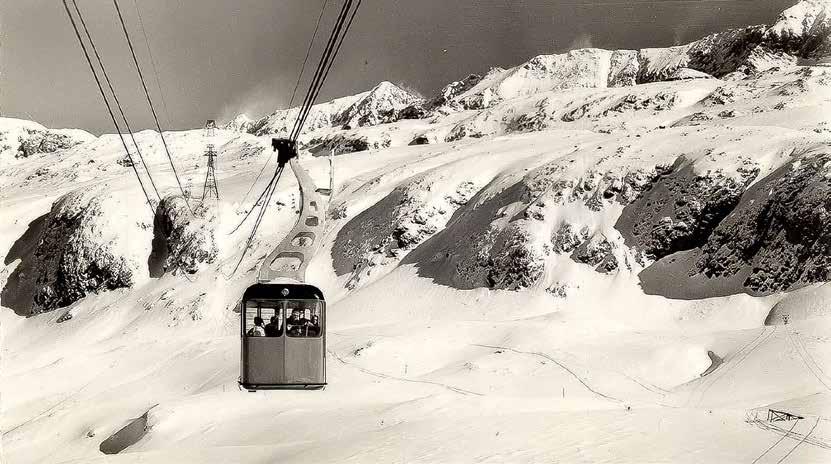
Edition 2024
For sustainable innovations INNOVATION BOOK

S yst è me AURO : Aprè s la t él éc a b i ne, l ' au t o no mie s e t ra nspose au t él ésiè g e
Après la nouvelle génération de télécabines AURO, 100% autonome, Doppelmayr automatise désormais l’exploitation des télésièges avec la technologie "Autonomous Ropeway Operation".
En Suisse et en Autriche, les Autorités ont déjà accordé le permis d’exploiter un télésiège sans opérateur en station amont. Deux installations pilotes ont précédé cette autorisation : une installation à Wildhaus (Saint-Gall, Suisse) et une autre dans le domaine skiable de SilvrettaMontafon (Vorarlberg, Autriche).
doppelmayr.com

“Everything Changes Because Nothing Changes?” INTRO
As MOUNTAIN PLANET celebrates its 50th anniversary, a delightful review of some archives has uncovered treasures. Nostalgia tinged with black and white photos, apt phrases that make perfect sense, and thoughtfully curated quotes highlight the richness of a fifty-year history.
Back then, MOUNTAIN PLANET was known as SALON AMENAGEMENT MONTAGNE, and already the late Michel Drapier, co-founder of the show, hinted at a reality of our professional world that could mirror ours today: “SAM is situated at the heart of the issue facing every man or woman concerned about the future of mountain regions. (...) SAM organizers have chosen the difficult path that consists of neglecting no trend, however minor.” His meaningful words live on today. It’s hard to say whether it’s true to say “everything changes because nothing changes,” but it’s clear that the creator of Montagnes Magazine had a keen intuition and a deep understanding of the mountain environment, which even back then, was divided over the impacts and effects of its development. Fifty years later, here we are, and without realizing it, MOUNTAIN PLANET has embraced this principle of leaving no one behind, no stakeholder who lives and vibrates on our mountain planet. Our show continues to strive to be the catalyst of all intelligences, the conduit for links past, present, and future. In the truest sense of the word, it EXPOSES without disguise all the themes related to climate and societal changes, as well as the brilliant ideas that come through innovation and lead to resilience.
In this fifth edition of our INNOVATION BOOK, it is quite striking to see the quantity and quality of new ideas brought forth by longstanding players, but also by young startups managed by people in their thirties. Whether it’s a platform that maps the thickness of the snowpack to optimize snow production; a 100% electric dirigible promising a wide variety of uses for an energy cost of less than 1 euro per flight hour; or a young company reimagining low-carbon travel by making it sexy; not to mention the extraordinary development of drones, which led us to dedicate an entire village to it this year.
At the foot of the mountains, we are all ultimately united... starting in the aisles of MOUNTAIN PLANET, which continues to “neglecting no trend, however minor.”
Jérôme Riff
General Director of Alpexpo

INNOVATION BOOK
IS PUBLISHED BY MOUNTAIN
General management: Jérôme Riff
Trade show managers: Laurette Bonzy and Nadine Chevalier
Design Production
EDITIONS COSY
GERANT : Claude BORRANI
SAVOIE Technolac
18, ALLÉE DU LAC ST ANDRÉ
73 382 LE BOURGET DU LAC CEDEX
Tél : 00 33 (0)4 79 65 46 10
Fax : 00 33 (0)4 79 65 46 12
Site Internet : www.cosy-design.com
Rédaction
Marie-France Sarrazin - Claude Trinidad
Véronique Pilon - Delphine Bertaux
On the cover
Alexis Cornu and OT Alpe d’huez
Traductions
InFact Global
Art direction & layout
Séverine Béchet • studiosbdesign.fr
Communications consultants
Fanny Marguet fanny@cosy-editions.com
Olivia Gontharet olivia@cosy-editions.com
Yannick Mougel yannick@editions-cosy.com
Kamel Beghidja kamel@cosy-editions.com
Administration and customer relations
Pascale Torque compta@cosy-editions.com
Périodicité : Annual
Printed
MOUNTAIN PLANET 2024 3 DR
ALPEXPO
PLANET
in France IMPRIMERIE POLLINA Degal Deposit: upon publication ISSN 2418-0297 Any reproduction or representation in whole or in part by any process whatsoever of the pages published in this magazine without the publisher’s permission is unlawful and constitutes an infringement. Only reproductions strictly reserved for the private use of the copier and not intended for collective use, and short quotations justified by the scientific or informative nature of the work in which they are incorporated, are authorised (art. L.122-4, L.122-5
L.335-2 of the French Intellectual Property Code).
and
INNOVATION BOOK#4 - MOUNTAIN PLANET - 2024

STORY
50 Years of Mountains, 50 Years Later!
Since 1974, Grenoble’s event park has organized and hosted the largest international gathering of mountain professionals every two years. Or how not to forget that what we see in the rearview mirror is always closer than it appears...
INNOVATION
What’s new on the booths?
Mountain Planet is, and has always been, the trade show for new products and innovations. A quick tour of what’s in store from the 434 exhibitors and 900 brands present at the 2024 edition.
Portraits
2 Innovators at the Mic Engineers, consultants, teachers, or researchers, they are all in pursuit of innovations.
Socially Yours
Social innovations: a roped party with values.


TRANSITION
Energy Transition in Resorts: Who’s Doing What?
Among the 71 countries represented at the show, many brands are taking actions with resorts to revise their approach to energy, environmental, and social issues.
Pioneering Resort
Serre-Chevalier, a look back at an advanced approach...
Sustainable Actions
Pierre Volaire, mayor of Les Orres, President of the Sustainable Peaks Commission: his three actions for a sustainable mountain...
A Decarbonized Mountain in Motion...
As mobility contributes to over half of the CO2 emissions in mountain areas, young companies are tackling the issue by offering less carbon-intensive travel solutions.
Interview
Philippe Matheron, Massif Commissioner, and Nicolas Gouvernel, Deputy Commissioner: “Creating the most widely shared development narratives is essential.”
EVENT
Highlights of the 2030 Winter Olympics
France will host the Winter Olympics in 2030. Alone in the race at the end of the candidacy process, the Auvergne-Rhône-Alpes and Provence-Alpes-Côte d’Azur regions clinched the deal in less than 6 months...
Interview
Laurent Wauquiez, president of the Aura regional council.
MOUNTAIN PLANET 2024 4 WWW.MOUNTAIN-PLANET.COM MOUNTAIN PLANET • ONLINE
Contents
06 14 38 62



SURVEY
What Will Be the Mountain Jobs in 10 Years?
FOCUS
The Rising Popularity of Valley Lifts
Whether it’s called a gondola, cable car, aerial tramway, or funicular... each of these devices for transporting people and goods between the valley and the mountain resort is now promoted under the name of valley lift.
Mountain Water Reservoirs
A Topic of Debate in France, But Not Everywhere!
So, is it good or bad to artificially contain water?
Quantitative Feedback
The dismantling of towers from old ski lifts is multiplying...
MOUNTAIN HABITAT & TRANSITION
Challenges
The Time for Renovation of Mountain Residences Has Come
Label
What’s the Value of the Green Snowflake?
BIM (Building Information Modeling)
Can it Help Build Greener?
The Circular Economy
Do You Know About “Cradle to Cradle”?
The Slow Rise of Electric Mobility in the Mountains
A Transition That Needs to Accelerate
What’s New in Real Estate Tech? Technology Serving Real Estate
INDUSTRY
Vive la France!
In mountain development, we are also witnessing the beginning of an industrial relocalization in France


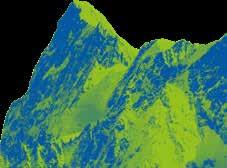
THIS IS THE END SEE YOU IN 2026 68 76 110 104 88

DR
MOUNTAIN PLANET
50 YEARS OF MOUNTAINS, 50 YEARS LATER!
Since 1974, Grenoble’s event park has organized and hosted the largest international gathering of mountain professionals every two years. Or how not to forget that what we see in the rearview mirror is always closer than it appears...
1968 : the Grenoble Winter Olympics, inaugurated by General De Gaulle, elevated Grenoble to the status of the world capital of winter sports, and winter tourism became a priority for land planning. Resorts sprang up, and there was massive equipment investment for snow and skiing, intended to “bring the mountain out of its isolation.”
Skiers flocked, even during seasons when the weather was warm as in 73/74, when there was no snow—a classic occurrence for the past 50 years.
1974 : this is when, between the euphoria and instability, Grenoble launched the Mountain Development Show. From its first edition, 150 exhibitors answered the call of a handful of men— Philippe Lamour, Raymond Coche, Paul Rambaud, Hubert Dubedout, Jean Roger, Jean Faure, Michel Lacroix, Jean Baccard, and Michel Drapier—who were convinced of its necessity. Their slogan, “Man and mountain come together.” Their ambition was to see all mountain ranges develop harmoniously. Back then, the notion of sustainable development and shared mountain spaces was already on the table.
1980s: the emergence of new snow sports propelled winter sports to new heights. Competition grew and marketing campaigns took a serious turn. In this increasingly competitive climate, the show was more than ever an essential meeting point.
Early 90s: snowfall became a rarity, inviting questions about the future.
“These pivotal years allowed planners, operators, and supplier manufacturers to get back to basics and regain footing in our strategies and the why of our operations,” recalls Jean Souchal, President of the Executive Board of POMA.
After various crises and snowless years warning of a bleak future for snow, the 2000s were full of topics about globalization, consolidation, hyperprofessionalization, and sharing expertise. Snow production became an important job creator as it was widely used throughout the world’s resorts. In parallel, global warming and new forms of tourism already began talking about diversification. “We shouldn’t be afraid to say that a winter sports resort can become a leisure resort in the broadest sense of the term. (...) Resorts must use everything they have to diversify their offer and interest a wider clientele,” analyzes Jean-Yves Remy, CEO of Labellemontagne
2020s: resilience and innovation continue to be the two essential assets of a mountain looking to new horizons. “We are growing together. That’s Mountain Planet’s goal, and the change is salutary. We will continue to support it because we will all be proud to invite people who are not initially from the world of skiing,” affirms Jean Souchal.
See you in 50 years!

MOUNTAIN PLANET 2024 7
STORY


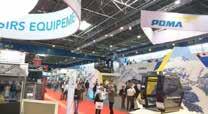

Passang Sherpa and Mountain Planet on the summit of Everest...
In 2016, Mountain Planet entrusted a small nylon banner featuring the show’s logo to Passang Sherpa, a low-profile hero of the Roof of the World, to unfurl at the summit of Everest to celebrate the opening of Mountain Planet in Grenoble. The symbol was strong: Mountain Planet embraces the ambition to become a world-recognized event on the highest summit in the world. Unfortunately, in that same year, 2016, a terrible earthquake caused the death of 8,000 Nepalis and also spelled the end for that year’s Everest expeditions. It was not until May 2017 that Passang was able to take this remarkable photo. The weather was excellent that day and Everest summiteers enjoyed excellent conditions. Mission accomplished! The Mountain Planet banner was able to flow in the Everest winds for a short time! Bravo to Passang Sherpa.


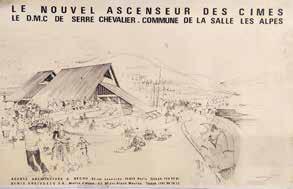

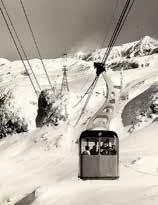

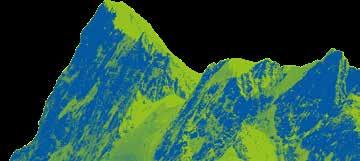
MOUNTAIN PLANET 2024 8
KIRAVOLKOV
GERSZEWSKI-ANDREA
DR DR DR DR DR DR





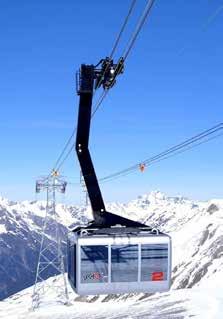

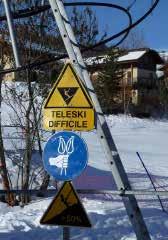






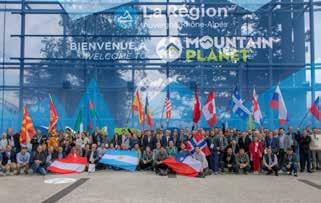

MOUNTAIN PLANET 2024 9
ALPE D’HUEZ
DR
1969_HISTORIE_ERSTER-PISTENBULLY DR
MONTAGNE-LEADERS-SCALED
OLIVIER-LESTIEN
DR POMA STORY
HERVE-DOULATOK



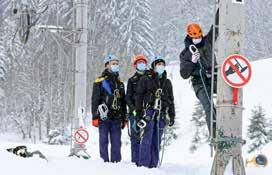

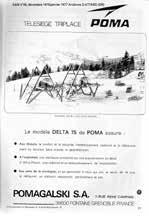
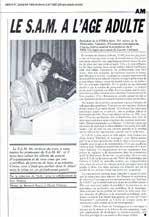



MOUNTAIN PLANET 2024 10 DR DR DR DR DR LUDOVIC-LAUDEDR SAFETY-GAZEX






GRENOBLE OLYMPICS ALPEXPO, AND MOUNTAIN PLANET: INTERTWINED DESTINIES
The Grenoble Olympics saw the birth of infrastructure and buildings on spaces previously dedicated to other uses, but always with the perspective of their reuse after the Games. The site of the former aerodrome was chosen for the Olympic bus station. It was then converted into an Exhibition Hall to replace the old buildings of the Grenoble fair, demolished to make room for the speed skating track and the ice stadium. In nine months, companies had to build infrastructures whose conversion was not yet clearly defined. Architect Jean Prouvé designed the station with architecture capable of responding to various uses and whose elements were schematized for easy and quick construction.
Classified today as «Remarkable Contemporary Architecture,” the building is a technological and architectural feat that has been hosting Mountain Planet for 50 years.



MOUNTAIN PLANET 2024 11 DR DR DR AFP AMMG
In 1968, Alpexpo, designed by the famous architect Jean Prouvé, was initially designed to serve as a bus station for the Grenoble Olympic Games before becoming what it is today...
A half-century of boldness

The largest international trade show for the mountain of tomorrow was created and developed thanks to the courage and tenacity of a handful of people who have greatly contributed to its creation, development, and future.
“SAM is situated at the heart of the issue facing every man or woman concerned about the future of mountain regions. (...) SAM organizers have chosen the difficult path that consists of not neglecting any trend, even if it’s a minority one.”
Michel Drapier, General Commissioner and co-founder of the show
“Mountain Planet is an exceptional trade show that connects operators from all over the world. What needs to be highlighted is Alpexpo’s willingness to integrate exhibitors in the direction, positioning, and actions of the trade show. There’s a fantastic collective intelligence that stems from this, it’s unique.”
Christian LAVAL, Associate Director - POMA
“Our vision for the future, in addition to our commitment to supporting the innovations of mountain stakeholders, includes a trade show organized in skills hubs; expanding these innovative solutions from mountainous areas to urban, rural, and coastal spaces; and our Mountain Expertise University (...) to promote the continuous development of this sector.”
Jérôme Riff, General Director Alpexpo
“For mountain development professionals, this global trade show is also a place for exchanging good practices that are sustainable and ensure a resilient future for our mountain ranges. The aim is to preserve them while allowing everyone to enjoy these magical places that are our mountains.”
Nathalie Béranger, President Alpexpo and Mountain Planet
“It’s the place to be, where we can dream about how tomorrow will be, and it’s also where we are known and know its players. We are proud of this recognition.»
Jean-Yves Remy, CEO Labelle Montagne
“It’s really a significant show in the mountain industry. It opens to the diverse activities that take place here.»
Jean Souchal, President of the Executive Board of Poma
“It’s really a point of exchange. We review past activity, and we look ahead.»
Laurent Travers, Sales Director TechnoAlpin
“After 26 years of involvement in organizing the show, I am proud to be part of this ‘great mountain family’ and to have contributed to the prominence of Mountain Planet, a key meeting place for companies with unique expertise shaping the mountains of tomorrow. The excellence of our show is the achievement of the current team and those before us, whether they are the front-runners or those working behind the scenes. My career ends beautifully with the show’s 50th anniversary, and I close this immensely enriching chapter with a lot of emotion and gratitude.”
Laurette Bonzy, Mountain Planet Trade Show Manager
“Mountain Planet is today one of the two leading professional trade shows in the world. This status was earned ten years ago—thanks to the exemplary effort and cooperation of mountain development players in France—and places the show in a position to shape the future.”
Claus Habfast, City Councilor of Grenoble
“Having served as president of the show several times, I worked closely with major manufacturers to establish alternating schedules with the Interalpin trade show. Since its inception, Mountain Planet has become increasingly international, let’s continue on this path!”
Jean-Charles Simiand, Former General Delegate of the National Syndicate of Aerial Ropeways and former VP of the International Ropeway Transport Organization
“The SAM was founded in 1974 from the boundless imagination of Michel Drapier, who passed away in 2022 after dedicating his career to the mountains. The expo hall—once a place where snow groomers, cattle, and cheese products were joined together—has evolved into a venue for exchange that has greatly broadened its horizons, maintaining its focus on the future of high-altitude regions,’ as Mr. Drapier called them. He was a publisher by trade, curious, and visionary; his remarkable contribution to our mountain territories that he loved so much will remain our legacy to all, especially through the magazine Montagne Leaders.”
Dominique Verdiel, President of Comalp.

MOUNTAIN PLANET 2024 12
STORY
MOUNTAIN PLANET IN 5 DATES
1974
1st edition of the Mountain Development Show
2000
Last edition hosting international cheese competitions
2008
Appearance of exhibition spaces dedicated to summer mountain activities with a sector dedicated solely to mountain biking
2013
SAM changed its name to become Mountain Planet
2024
The largest international trade show for the mountain of tomorrow celebrates its 50th anniversary



ALEXIS CORNU 2024 13 STORY
He said
WHAT’S NEW ON THE BOOTHS?
BY MARIE-FRANCE SARRAZIN AND CLAUDE BORRANI

SOLAR CARPORT FOR ELECTRIC BIKES
The French company Sunwind Energy has developed an innovative photovoltaic station for charging electric assist bikes directly at 220 V, either connected to the grid or independently with battery storage. This carport, made of aluminum structure, withstands weather conditions from -20°C to 70°C, impacts, and vandalism, can be quickly assembled, is durable, customizable, and modular.

“The mountain has a future.
The snow should not be thrown out with the lake water.”
Joël Giraud, former minister, deputy of Hautes-Alpes
AN INNOVATIVE AND ECOLOGICAL PROJECT WITH AN OPENING PLANNED FOR SPRING 2024
Connecting the hamlet of Fayet to the center of the commune of Saint-Gervais, this is France’s first sewage-powered inclined elevator. Based on a unique technical approach, this elevator has the innovative feature of utilizing the sewage network for its operation. True to the LIFE R’way approach of the POMA group, aiming to put innovation at the service of the environment, the Thermal Elevator is ecological in its operation. Indeed, the project presents a reduced carbon footprint with a ballast system allowing for ascension with low energy consumption, capable of transporting up to 16 passengers per trip.

It will climb the 177 meters of elevation in less than 5 minutes, with a 44-degree slope.
This project is at the heart of a scheme to reinvent mobility in the Saint-Gervais agglomeration. Indeed, in addition to the Thermal Elevator, a valley elevator will connect the SNCF train station of Fayet and the center of Saint-Gervais. This is the result of a successful partnership with STBMA (the company delegated for the Bettex Mont-d’Arbois ski lifts). This installation aims in particular to decongest traffic on the adjacent departmental road and offer residents and visitors an alternative solution for their travel within the commune.
The Luggage Carrier
Since 2015, the French company TwinswHeel has been manufacturing droids that assist humans in their logistical and laborious tasks in cities and even in the mountains. The ciTHyM model carries vacationers’ luggage and skis from the parking lot, train station, or bus stop to the hotel or rental property. These autonomous or following electric vehicles, equipped with sensors, can carry up to 150 kg of luggage. Silent, modular, non-polluting, they offer a real solution for last-mile logistics by reducing the number of vehicles on the roads.
MOUNTAIN PLANET 2024 14
DR INNOVATION
TWINSWHEEL
17,8%
This is the percentage of reduction in the number of ski lifts in France over the past 20 years, dropping from 3,700 devices in 2010 to 3,040 in 2022, without reducing the number of slopes. Ski areas are rationalizing to offer equivalent throughput with fewer devices.
Augmented Reality Ski Mask
Snow and fog on the slopes can prove treacherous for skiers lacking visibility. The startup Provuu has designed an augmented reality ski mask to enhance contrast in whiteout conditions. These revolutionary glasses switch on demand between transparent mode for blue-sky moments and immersive mode for improved visibility.

Solar Tile
Combining photovoltaics with aesthetics is possible. Inspired by traditional slate roofs, the SunStyle solar tile is the only photovoltaic roofing system integrated into the building that has a certification for installation in mountain climates: its reinforced structure can support snow loads of up to 1300 kg/m². Its design blends harmoniously into the landscape, while generating electricity and protecting the building from harsh weather. This solution, proven over many years in Switzerland, has been chosen to cover the Club Med in Peisey-Vallandry and another roof in La Toussuire. Further studies are underway in Megève and Châtel.
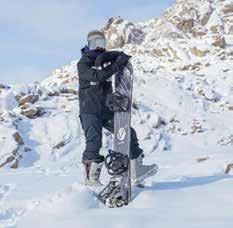

HARNESSING MAGMA HEAT
Finding an unlimited renewable energy source at low cost is what a team of researchers will attempt by drilling a tunnel to the magma chamber of the Icelandic volcano Krafla in 2026. The drilling is expected to last two months and reach a depth of two kilometers. Accessing pockets of molten rock would, at a minimum, increase the efficiency of future geothermal power plants tenfold. The magma reservoir of this volcano was accidentally discovered in 2009 by geologists prospecting for new geothermal fields. A stroke of luck as it remains very difficult to precisely locate the position of a volcano’s magma chamber, and there’s also concern that such an experiment could trigger an eruption.
A significant challenge awaits the researchers: the durability of equipment in these extreme conditions. Work will begin with a phase of scientific observations before considering the exploitation of magma as an energy source.

And the E-snowboard was Born!
The American company Cyrusher has designed an electric snowboard, equipped with a 3000 W motor, capable of climbing 20% slopes and reaching speeds of nearly 50 km/h. The motor is connected to a remote control and a battery placed in a backpack. It allows for movement both on flat terrain and on steeper snowy trails. Such a device remains subject to legal restrictions in France, identical to those for electric snowmobiles, limiting its use to well-defined circuits.
MOUNTAIN PLANET 2024 15
CYRUSHER DR PROVUU SUNSTYLE
INNOVATION
DROP-OFF AT THE SLOPES WITH UBER
Uber is offering a new service, UberSki, to bring vacationers to the foot of the slopes, departing from Geneva, Lausanne, Berne, and Zurich. About thirty Swiss and French resorts are served, with prices ranging from 140 to 390 CHF depending on the destination.
+40% EFFICIENCY
This is what the Austrian resort of Sölden hopes to achieve by installing vertical photovoltaic panels in a cross structure on the Tiefenbach glacier, at an altitude of 2,850 meters. Designed by Helioplant, these bifacial modules combine several advantages: spacesaving, better reflection, and panels free of snow. “During the period when we need electricity the most, there is usually a lot of snow on the roofs, which greatly limits the efficiency of flat photovoltaics on rooftops,” estimates the project manager of the lift company, Eberhard Schultes.

Artificial Glaciers for Crop Irrigation
As some regions of the world suffer from increasingly severe water shortages, affecting agricultural activities, drinking water supply, and local ecosystems, scientists are experimenting with the creation of artificial glaciers.
In the Andes, the Nilus project, led by Chilean engineers, draws inspiration from the achievements of Indian engineer Sonam Wangchuk in Ladakh. The principle is as follows: in winter, when the water from mountain streams is abundant but underutilized, it is diverted through underground pipes. As it emerges at the surface, the water freezes upon contact with the cold air, forming ice domes. These artificial glaciers store water during the winter and release it during the dry season for crop irrigation.
In 2015, Sonam Wangchuk built the first 20-meter-tall ice stupa. It melted in April 2017, releasing water that was used to irrigate newly planted poplars in the fields.
These domes, erected between 3,200 and 4,300 meters in altitude, can reach 40 meters in height and store 9 to 10 million liters of water.
The Indian engineer has since built 50 other ice stupas, including in the Swiss Alps in 2022.
In the Andes, the principle led to the construction of an ice structure 3 meters high and 6 meters long. This experimentation remains expensive, nonetheless.
In Switzerland, the Monteratsch glacier has already lost nearly 3 km in length since the 19th century. Swiss and Dutch glaciologists have come up with the idea of creating artificial snow from meltwater, stored during the summer, to cover the glacier during the winter months.

MOUNTAIN PLANET 2024 16 SÖLDEN ONCE NOTICIAS
INNOVATION
OFFICES HEATED BY A GONDOLA LIFT
In Valmorel, on the new Planchamp gondola lift, a system for recovering the hot air produced by its converters is used to heat operator offices and the staff canteen. The resort had already tested the process on the La Biollène and Mottet chairlifts as well as the Celliers gondola lift.

3D Mapping of the Snow Cover Engineers
Julie Aubert, Charlotte Brenac, and Nicolas Guibal founded the Toulouse-based startup Elda Technology in January 2023, and have already signed a partnership with the high-Alpine resort of Serre Chevalier. Their platform for mapping the thickness of the snow cover, to within plus or minus 5 cm, optimizes snow production and secures dangerous areas with a high risk of avalanches. How is this possible?
Through a drone equipped with a Lidar sensor. Data from the analysis of the snow cover is then automatically processed in a few minutes. Clients thus receive a 3D mapping of all snow heights across the entire area, including in hard-to-reach zones. Indirectly, the tool helps operators to determine the most opportune places to install snow machines or ski lifts. The solution, tested at Serre Chevalier, will also be tested at the high-Savoyard resort of Grand-Bornand before being marketed at the end of 2024.
In parallel, the startup is working on a new functionality dedicated to predicting snowmelt, in collaboration with researchers from Isae-Supaéro and the Serre Chevalier resort. Starting next year, it will be possible to estimate the state of the snow cover over 10 to 15 days to produce snow as accurately and in the right places as possible.
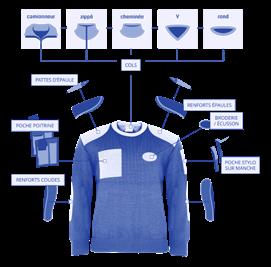
First Seamless Thermal Underwear
Regain, a specialist in professional clothing, offers its first seamless thermal underwear, guaranteeing comfort, ergonomics, and suitable to be worn as a base layer against the skin. Composed of 60% wool and 40% viscose, it keeps warm and quickly wicks away sweat. Moreover, its 3D knitting produces no waste.
IT’S COMMON SENSE!
“Sens Architecture and Sens Montagne agencies have designed a wooden jewel, a new shared space, at the heart of the Bourg d’Oisans village.” Creative and innovative architecture made of delicately assembled, raw wood sections to form wide contemporary arches. This hall project contributes to the objectives of environmental quality, highlighting local resources, and valuing the craftsmanship of Oisans.”

MOUNTAIN PLANET 2024 17 SENS ARCHITECTURE DR INNOVATION REGAIN
ENERGY SAVINGS THANKS TO LEITNER
Leitner has designed two systems that allow ski lift operators to achieve energy savings. Savings can reach up to 20% by using EcoDrive, which automatically controls the speed of the ropeways. Integrated into the control system, it regulates the pace of the operation using a camera system that counts waiting visitors at the stations, as is the case at Serre Chevalier. The potential savings were measured on two different installations, over 23 and 21 days respectively in the 2021/2022 season. This resulted in savings of 7550 kWh and 5000 kWh. With DirectDrive, a gearless drive system, Leitner allows for a 5% energy saving.
All-terrain Kart
The mountaincart, available in 20 countries, allows for descending gravel paths, asphalt, meadows, or snowy trails and can be transported by any type of ski lift. These mountain karts are entirely made in Upper Bavaria. Its very low center of gravity and wide wheelbase ensure very good road holding, its special hydraulic disc brakes guarantee maximum safety on long descents and steep slopes, and its aluminum frame makes it very maneuverable.



SKIING STILL ATTRACTS
The 2022/2023 season faced difficulties in France, including a low-snow winter, an unfavorable school calendar, and a challenging social and economic context. Despite this, ski resorts fared well, as confirmed by the report from DSF, with only a 5% decrease in ski area attendance compared to the previous winter.
After the health crisis, the return of foreign customers was confirmed, with a strong presence of British, followed by Dutch, Belgians, and Swiss visitors. With its 51 million ski days (and 1.6 billion euros in ticket sales), France remains the world’s second-largest ski destination after the United States. However, the costs for the resorts have increased dramatically. On one hand, collective bargaining wages were re-evaluated (+7% at NR 200). On the other hand, some areas saw their electricity bills multiplied by 5 or even 10. Fortunately, work on electrical sobriety has borne fruit, and consumption has been reduced.
Cable with Reduced Carbon Footprint
ArcelorMittal offers the first ski lift wire rope designed with a reduced carbon footprint, using recycled steel and 100% renewable energy throughout the manufacturing process. This approach is part of the group’s effort to reduce its CO2 emissions to achieve a carbon-neutral footprint by 2050.
MOUNTAIN PLANET 2024 18
LEITNER
MOUNTAINCART
INNOVATION
A STARTUP TURNING OTHER COMPANIES INTO DECARBONIZATION HEROES
Meet take[air], a startup turning other companies into decarbonization heroes. Discover our carbon management platform conformed with ADEME’s methodology® and let our Carbon Killers take care of your Greenhouse Gas emissions in order to reduce your carbon footprint..
Paper Surfboard
Designed in collaboration with Swedish snowboard photographer Vincent Skoglund, Papersurf, a binding-free snowboard made from a biomaterial called papershell, results in 98% less CO2 emissions. Composed of multiple layers of compressed paper replacing fiberglass, the material is just as durable. This product is said to be practicable on all types of snow.
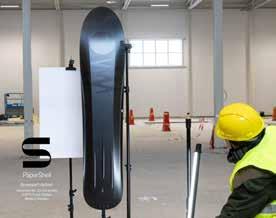
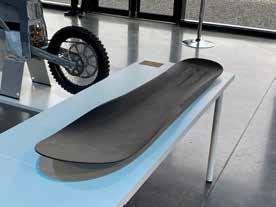
Cross-border Data Collection
Since October 2023 and for two years, the Nice Côte d’Azur metropolis, the Piedmont and Liguria Regions, the European cross-border mission, the Principality of Monaco, and the Genoa metropolis are leading a European project Interreg-Alcotra, Observ’Alp, costing €500,000. This area was not chosen randomly since its population easily transits from one country to another, especially for work.
All these partners will create a foundation of interoperable data across the three borders by collecting, analyzing, and sharing it. The lead partner of the project, the Provence-Alpes-Côte d’Azur Region, through Data Sud, will be responsible for managing the storage database and will also work from the collaborative platform Expertises et territoires.
The basis of this collaborative work will start with a detailed knowledge of these different territories, their population, their mobility networks, their public services, their natural risks, their climate challenges, their economy... Once the common cross-border issues are identified, actions can be taken in terms of mobility, economic sector development, and the management of health and climate crises.


MOUNTAIN PLANET 2024 19
HILLEVI HESSELDAHL
INNOVATION
HILLEVI HESSELDAHL

PARTNER CLUSTER MONTAGNE
act together for a living and shared mountain
Over the past 12 years, the Cluster Montagne has become an essential element of the mountain’s economic landscape. Focused on reflection, but even more on action, its missions have evolved along with the transformations in the environment. “Collective intelligence makes sense if it is put into practice and this is one of our strengths. We move!” says Patrick Grand’Eury, the Cluster’s President for the past 6 years. Here, he takes a look back over his years in office.
“The crises we have gone through (Covid, the energy crisis) and the challenges of climate change have strengthened our belief in the importance of continuing our actions in support of our four fundamental pillars: network, innovation, growth and sustainable development. An important turning point of the past few years was creating closer on-place links through the Cluster Montagne Labs initiative. We talk to the players and local elected representatives and we work on R&D projects with our members. Development, transition, construction, risk management, impact reduction, etc., the idea is to provide solutions and encourage co-innovation. To conclude my term of office, we have been working with the governance and operational team on defining our raison d’être: “To take collective action for a living, shared mountain”. This means that we no longer intend to develop at all costs. However, when we talk about a “living mountain”, we mean in the context of tourism, particularly in winter. Today, our elected representatives and professionals still need this economy, if only to finance the transition and prepare for the future. We know that tomorrow will be different and that major changes are underway and we are going to support them. The Cluster Montagne’s priority is always to support businesses and it just so happens that that helps everyone. The more we work with the territories, the more ideas will emerge. I am campaigning for us to build our own future, not to have it imposed on us”.


AN INTERNATIONAL VOCATION
During the Mountain Planet trade show, the Cluster Montagne’s mission is to organise the visit of international delegations: “We invite players from other countries to our events and go and see what is being done elsewhere in terms of development, tourism, energy, customer experience, etc. We have created a strong international dynamic and we have a real role to play in the relationship with the world’s mountain decision-makers”.
MOUNTAIN PLANET 2024 20 RENCONTREZ VOS FUTURS PARTENAIRES FAITES-VOUS CONNAÎTRE IDENTIFIEZ LES TENDANCES ACCÉLÉREZ VOS PROJETS VALORISEZ VOS INNOVATIONS MESUREZ VOTRE IMPACT AGISSEZ POUR RÉDUIRE VOTRE EMPREINTE VALORISEZ VOS BONNES PRATIQUES IDENTIFIEZ VOS OPPORTUNITÉS DE MARCHÉS DÉVELOPPEZ VOTRE BUSINESS EN FRANCE ET À L’INTERNATIONAL SUIVEZ L’ACTUALITÉ DE LA FILIÈRE RENFORCEZ VOTRE CAPITAL HUMAIN OBJECTIFRÉSEAU DÉVELOPPEMENTDURABLE OBJECTIFCROISSANCE OBJECTIFINNOVATION FOCALIZE


Au sommet en toute sécurité



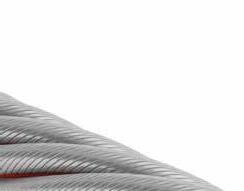



Venez nous rendre visite à MOUNTAIN PLANET 16-18 avril 2024
Alpexpo, Grenoble


SOLITEC ® Max7

www.teufelberger-redaelli.com


Stand 858 : Rencontrez notre équipe dynamique et découvrez nos dernières innovations.


Vous trouverez plus d´informations sur nos projets de référence :
© Leitner
WHAT’S NEW AT DOPPELMAYR
The TRI-Line is Doppelmayr’s latest and most innovative 3S technology. It combines the advantages of the tri-rope system with those of the D-Line generation of aerial tramways, with its centerpiece, the brand new eight-wheel carriage. Capable of supporting significant elevation changes, it allows for long rope spans, has great wind stability, and a transport capacity of 8,000 people per hour.
The latest D-Line development is equally impressive. With the 20-MGD, Doppelmayr has created a unique monorope system, especially in urban environments. The new D9000 double grip supports a carrier that can accommodate up to 20 people. Autonomous operation AURO is possible with this variant. These two new systems have one thing in common: the new Stella cabin, with a capacity of 20 people. Opening on both sides, it allows for easier passenger flow management and more efficient material transportation.
Among the innovations is also the authorization to operate autonomously, thanks to AURO, two chairlifts in Switzerland and Austria, a principle previously reserved for gondola lifts since 2020.
Doppelmayr has also launched a software, Clair, to manage aerial ropeway installations, as well as other equipment like snow cannons, grooming, buildings...



Freeriders say thank you!
No fewer than 200 skiers disappear each year due to avalanches, especially among the freerider population who enjoy a unique but dangerous pleasure. This observation led to the creation of the IVAQ Finder, a drone equipped with an avalanche victim detector receiver capable of locating a beacon within a 200 x 200 meter area in less than 5 minutes. With its compact and foldable design, it has the advantage of being quickly deployed, in less than a minute it can provide patrol units with a rapid and efficient response capability in these scenarios where time is crucial, as we know.

MOUNTAIN PLANET 2024 22 DOPPELMAYR
INNOVATION
NOTHING STOPS VISORANDO
For several years, the participatory platform Visorando has made it possible to find, share, prepare, and take hikes. Over 29,000 routes in France and abroad are now available. Visorando continues to gain more users, with 25 million visits to its website in 2022 and 2.1 million downloads of its application. Always seeking improvement, the Alsatian company will provide a tool to report any type of incident encountered on the trails and to list points of interest. With the acquisition of its English counterpart Plotaroute, Visorando accelerates its deployment in the UK and even across the Atlantic €140M
This is the growth plan for the coming years by Grandvalira Resorts, which manages the resorts in Andorra. While the French Pyrenees resorts are questioning their economic model, Grandvalira Resorts continues to bet on winter sports.

Eco-Driving Assistance
Sivao describes itself as the third eye of ski lift operators. On both chairlifts and gondolas, this system ensures that boarding is carried out under optimal safety conditions and alerts the operator if necessary. The company Bluecime has added a functionality to Sivao, by integrating Eco. Without additional equipment, this module analyzes seat occupancy in real time and offers the operations manager an overview of each lift’s eco-driving potential to guide operational teams towards relevant speed changes.

A Collaborative GPS for Skiers
Launched in mid-December 2023 exclusively in the Trois Vallées, the GPS Skiif application received a tidal wave of requests for coverage of other resorts. Beyond its orientation function on ski areas, Skiif, compared to Waze, is based on a collaborative principle to report wait times at ski lifts, share one’s location with friends, report closed or icy slopes, find toilets. Its roll-out will be rapid. Next winter, the application will be accessible in 160 Alpine resorts, in France, Italy, and Switzerland, and then in several American, Canadian, and Japanese resorts.

MOUNTAIN PLANET 2024 23 SKIFF INNOVATION
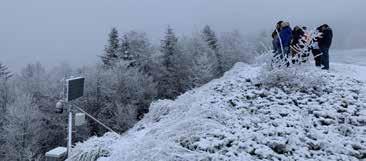
AUTOMATED AVALANCHE PATH MONITORING
In the Pyrénées-Atlantiques, in the Aspe valley, it happens that roads are closed due to avalanches. 47 km of roads are concerned. Until now, manual release poles were installed in avalanche paths. Surveys sometimes were impossible to carry out due to weather and access conditions... The Haut Béarn community of communes therefore installed at the end of 2023 new automatic and real-time monitoring systems in three risk areas. The system consists of high-definition cameras to capture several photos a day of the 27 monitored paths, snow-meteorological stations, and automatic snow poles that analyze the risk of avalanches ending their course on the road and assist public authorities in their decision-making.
ON-DEMAND TRANSPORTATION
Since last December, the Swiss resort of Grisons, Flims, has the first gondola equipped with the Ropetaxi system, developed by Bartholet. The first section of the Flem Xpress, linking Flims to Foppa and Startgels, is operational. The second will be by the end of 2024. The principle: cabins only circulate on demand according to the destination previously chosen at a control panel in the valley station. Access to the cabins is step-free, and at a stop, generating less stress. The journey is direct, without stopping at intermediate stations, like a taxi.
Like a classic gondola, Flem Xpress moves on a rope. But in the station, the cabins move autonomously on rails, thanks to their own drive system. These 120 ten-seat cabins can accommodate skis, snowboards, mountain bikes...
The result of this on-demand transport: energy consumption can be halved by avoiding unnecessary empty trips. This also means less wear and tear, so less maintenance and repairs.

Fishing for Wind
It looks like a kite. Yet, it’s a new kind of mobile, airborne wind turbine developed by the startup Wind Fisher. It seeks wind where it blows. Its cylinder, rotated by the wind’s force, is connected to a mobile station by cables. A generator converts this movement into energy. The secret lies in the use of the Magnus effect, well known in ball sports. Depending on the hit, different effects can be produced. The rotation induces a pressure difference between the two sides of the ball, which is then displaced towards the side with lower pressure.
A single airborne wind turbine could supply electricity to about fifty households. Compared to a traditional wind turbine, it can be up to twice as efficient and produce electricity 50% cheaper. If the startup manages to mobilize the necessary funds, the wind turbine will be marketed within four years.

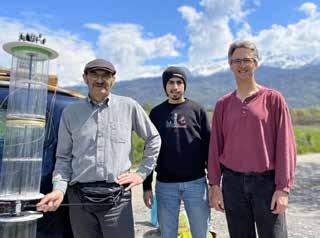
MOUNTAIN PLANET 2024 24 WIND FISCHER CCHB BARTHOLET WIND FISCHER
INNOVATION
Armand Tardella and Garrett Smith, co-founders, besides their first collaborator Yacine Boucheriguene, engineer.

ArcelorMittal’s New Ropeway Cables
CLIMBING TO EXCELLENCE

Whisper cable

Reinforced bandage

Les 3 innovations ArcelorMittal, l’âme de la durabilité …
The Low CO2 Emission Wire Rope
Its new XCarb(r) material is produced using 100% green energy, and its steel wire can contain up to 100% recycled steel. ArcelorMittal is the only global player to offer wire ropes whose CO2 emissions are three times lower than those of a standard wire ropes.
The Silent Whisper® Rope: A Globally Unique Technology
The innovation lies in the Whisper® rope’s monobloc core. It increases the contact surface with the interfaces. The rope is quieter, and vibrations are reduced by 80%. Therefore, there is less wear and less maintenance on the entire structure. Thus, the ropeway has a longer lifespan, providing significant comfort to users.
Reinforcing Splices with an Innovative Bandage
The new bandage is made from a reinforced, armored material. It allows for increased resistance to traction, deformations, creep, and fatigue. The resistance to punching is four times higher. Hence, there will be fewer maintenance interventions on the rope, the ropeway’s operational time will be longer, delighting customers.
ArcelorMittal’s wire ropes are manufactured in France , in Bourg-en-Bresse, by a team of 250 employees.

Contact ropeway.ropes@arcelormittal.com
ArcelorMittal teams are at your available at booth 146, Aisle 1 (opposite Poma).
+33 4 74 32 82 57
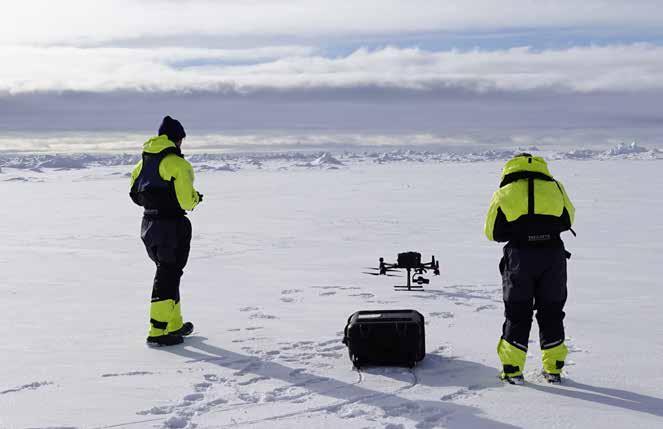
A DRONE VILLAGE AT MOUNTAIN PLANET
This year, the drone village makes its appearance, marking a significant step in the integration of aerial technologies in mountainous areas. By bringing together renowned companies such as i-TECH, ARTECH’DRONE, INSTADRONE, ALLUMEE, and AIR COURTAGE, this physical space within the exhibition hall becomes a hub of innovation and expertise in the field of professional drones. Interest in these aerial technologies is also present within major groups such as EDF, present at the drone village, which attributes significant importance to the creation of a section dedicated to drones within its general technical department.

These technologies go beyond mere surveillance and mapping, but also offer crucial solutions for mountain safety.
Thanks to their thermal cameras and agility, drones have become valuable allies in risk prevention and search and rescue missions for people in distress.
Moreover, the drone village explores new pass, such as the creation of environmentally friendly light shows, thereby demonstrating the incredible versatility and potential of drones in diverse fields including security, entertainment, and environmental preservation.
Significantly, state services, civil security, and the gendarmerie have also invested in the use of drones, employing them for surveillance, search, and rescue missions in mountainous areas. This initiative underscores the growing importance of drones in public security operations and their ability to save lives in mountain emergency situations.
MOUNTAIN PLANET 2024 26 I-TECH AU GROENLAND INNOVATION
Why Resorts Love Drones
Their ability to carry a thermal camera, a 250x zoom that can show the reference of a bolt from a hundred meters away, their rapid deployment in difficult areas, in unpredictable weather, including at night, gives them considerable advantages.
Monitoring the snowpack, structures, searching for victims, checking the thermal efficiency of a building, capturing tourist images, optimizing the production of artificial snow: the applications are numerous.
And this is just the beginning. Patrolair announces new uses, including medical or logistical transport. A drone is already capable of carrying 30 to 50 kg. “Tomorrow probably 100 to 200 kg,” comments Antoine Fleischmann, CEO of Patrolair.
NEW PROFESSION
Les Orres resort itself trained three drone pilots in mid-2023. Stéphane Henry, head of the slopes service, describes the drone as an efficient, fast tool that avoids unnecessary risks for teams, from having to move across the resort, thus contributing to the reduction of greenhouse gas emissions. “For ski lifts, we look at all the moving parts. We do pre-maintenance visits without climbing up every tower. We inspect avalanche prevention installations, which are quite inaccessible, and we assess the results of the shots,” details Stéphane Henry.
“In case of a breakdown on a lift, the difficulty lies in informing the stranded customers. A drone communicates the right messages and allows us to know exactly the number of people in the cabins before implementing the rescue plan,” adds Cédric Perretier, director of the slopes service for the 3 Valleys.
In terms of rescue, the tool locates victims under the snow, injured people, those lost on a resort, reassures them, equipped with a loudspeaker and a beacon… It clears doubts, sometimes avoiding the mobilization of a helicopter and a rescue team.
For Antoine Fleischmann, the drone is an additional asset that fights the number one enemy of rescue operations: time. But there is still progress to be made: “We are focusing on beacon detection, better collaboration between helicopters and drones so they can work together within two or three years, communicate in real time, and see each other.”
The Les Orres Drone Excellence Center has already trained 21 drone pilots in all these applications, in strict compliance with regulatory frameworks and safety rules, and helped resorts integrate drones into their operations, constantly seeking improvement through feedback and the sharing of best practices.
For resorts, the investment represents a cost—count €5,000 to €30,000 per drone, plus the thermal camera, Lidar—but is quickly amortized given the quality and capabilities of the device.
For ski lifts, we look at all the moving parts. We do premaintenance visits without climbing up every tower.

MOUNTAIN PLANET 2024 27 PATROLAIR INNOVATION
INTELLIGENT SNOWMAKINGT
The ATASSpro control software, developed by TechnoAlpin, allows for efficient snowmaking operation planning for more sustainable and optimized water resource use by combining weather forecast and upcoming snow production modules. The new version of SnowManager precisely determines the required snow volume for ski slope opening and operation based on snow depth measurements, weather forecasts, and operational parameters.

New Developments in Avalanche Triggering
With over 3,000 gas avalanche triggering systems deployed in 22 countries, MND Safety positions itself as a global leader in comprehensive avalanche risk management through its patented products for preventive triggering, monitoring, decision support, and avalanche start detection.
Among these, Safety-cs ensures snowpack monitoring, expolser activation, and avalanche detection remotely from PCs, smartphones, tablets, and connects to all MND devices, including Avawatch, a system for capturing and modeling avalanches that allows operators to verify the results of remote avalanche triggering. It consists of an autonomous seismic sensor placed in the avalanche path downstream of the exploder, recording avalanche activity and, following an explosion, confirming to the operator whether an avalanche has occurred and modeling its strength.

PRECISION SNOW GROOMING
Embedded in snow groomers, the SNOWsat LiDAR solution by Kässbohrer is revolutionizing the sector by measuring snow depth up to 50 meters ahead and around the vehicle.The benefits for both the environment and operators are significant: reduced fuel consumption, lower pollutant emissions, soil and flora preservation, water and energy savings, targeted snow stock creation and usage, increased productivity, and enhanced safety.
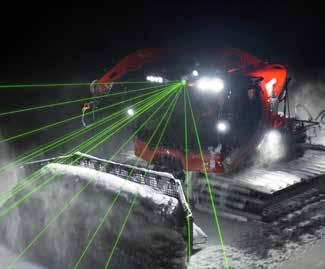
MOUNTAIN PLANET 2024 28
TECHNOALPIN
MND
SNOWSAT
LIDAR
INNOVATION
Adrenaline in the Colombian Wilderness
In Colombia, at Santa Sofía-Boyacá, the Paso del Angel adventure park caters to thrill-seekers unafraid of heights. The park’s name comes from the ridge it leads to, a narrow pass 35 centimeters wide, flanked by two deep chasms. This sets the tone.

The park offers 11 adventure challenges and two kilometers of mountain trails: high rope games, bridges and platforms of all sorts, cable biking, suspended catamarans, sky hammocks, zip lines. The area opened in 2021 after restoration and reforestation work.
Generating Electricity through the Artificial Snow Network
In 2016, the La Thuile ski area in Italy became the first in the world to use its snowmaking facilities to generate clean, renewable electricity, assisted by its snowmaking provider, the Savoyard MND.
The developed hydraulic system uses the water’s force, coming from a high-altitude reservoir through the snowmaking network’s pipes to be transported down to two turbines. The electricity produced, in spring and summer during snowmelt, is fed back into the Italian grid of Compagnie des eaux du val d’Aoste.
The operator produces 1.2 to 1.8 gigawatt-hours (GWh), covering 80% of the winter consumption of the snowmakers.
In France, the high-Alpine resort of Serre Chevalier installed the same system, which will also be used in Courchevel.


PROTECTED BIRDS
For three years, the Vanoise National Park led the European Birdski project in collaboration with the Observatory of Mountain Galliformes and the HauteSavoie Natural Spaces Conservatory. The goal: to reconcile the protection of mountain birds with socio-economic activities, to better share space in 17 ski areas in Savoie and 19 in Haute-Savoie. Program cost: €490,000.
Key initiatives include equipping 57 linear kilometers of ski lift ropes and dangerous Catex with beacons to prevent bird collisions. Five tranquility zones were created, marked by stakes, elastic bands, and flags.
The actions were evaluated using GPS tracking on birds to monitor their movements within ski areas, sensory ecology research to better understand how black grouse perceive their environment, and thermal and infrared imaging to track bird movements near ski lifts. These new insights will help better protect birds by improving tranquility zones and adapting cable visualization equipment in ski areas.
MOUNTAIN PLANET 2024 29 MND
INNOVATION
PARC DE LA VANOISE PASO DE ANGEL

COLLABORATIVE WATER MANAGEMENT IN SWITZERLAND AND ITALY
To enhance the monitoring of mountain lakes between Italy and Switzerland (Como, Maggiore, Lugano, Varese), the Simile project, conducted from 2019 to 2022 for €1.3M and co-funded by Europe, relied on public participation in data collection on the lakes through an app. The public could view information on an interactive map, send photos and comments, and take water measurements. Ideal for reporting the presence of algae, foam, waste, or pollutants, and for measuring water temperature or pH.
This complemented the use of sensors placed in the lakes and satellite maps. In Lake Maggiore, a buoy equipped with sensors was installed near Pallanza to analyze pH, oxygen, chlorophyll, and algae pigments. Equipped with a weather station, it recorded wind direction and speed, air temperature, solar radiation, and atmospheric pressure.
The combined use of citizen science, sensors, and satellite maps improved water management and the authorities’ response capacity. For example, satellite maps helped delineate the spread of a surface foam in Lake Maggiore in September 2019 and the proliferation of cyanobacteria in Lake Lugano at the end of 2019.
l’aérOnde, 100% electric-powered aircraft
Buoyant with helium, capable of vertical takeoff and landing (eVTOL), ensuring safe flight for up to 2 people and cargo, in silence, with very little energy consumption, for several hours. l’aérOnde features wireless control (Fly by Radio), a first in aeronautics. Its freedom of movement and positioning in space is unparalleled worldwide.
l’aérOnde targets a wide range of uses in aerial work, observation, tourism and leisure flights. For instance, it can serve as an environmentally friendly alternative to helicopters, offering silence, minimal energy consumption, long-duration missions and excellent stationary point control.

ARTIFICIAL SNOW COVERAGE
• France: 39% of slopes
• Italy: 90%
• Austria: 70%
• Spain: 50%
• Slovenia: 40%
Did you know?
The French mountain tourism development sector comprises over 450 companies, 5,500 employees, and an annual turnover of more than one billion euros.
Source Cluster Montagne
• Romania: 70%
Source: ANCT study “European Perspectives on Member States’ Policies against Climate Change in the Mountains,” 2023

MOUNTAIN PLANET 2024 30 MSTUDIOIMAGES DR
INNOVATION
Alert Against Rockfalls

Hellomac, a device designed by Maccaferri, is a real-time alert system for detecting impacts on rockfall and unstable block protections. It sends alerts via SMS, email, or through an app. With a five-year battery life without the need for electric power, it can even operate in remote areas without phone coverage, as it transmits data via satellite.
Eighteen units were installed for the first time in France at the La Rochaille site in the Alpes-de-Haute-Provence. This pass, located on the RD900, is a major link between France and Italy via the Larche pass. Maccaferri has paired its rockfall protection with its Hellomac alert system.
Did you know?
After creating a data factory, a data management platform, in 2022, Club Med has been using generative artificial intelligence since 2023 to continue improving the customer experience and optimizing its teams’ working time.
Now, the 5 million new daily data are processed in near real-time, low-value tasks such as indexing and automatic image sorting are automated, marketing content intended for international customers is translated, and a conversational agent is deployed in different markets to guide customers.
To oversee this practice, an ethics committee has been established.
PREDICTING LIFT LINES
The Grenoble-based company Bluecime is known for its safety rail securing solution for ski lifts, used in about sixty ski areas. Over time, the software has gained new features that allow for precise tracking of users on the lift, including whether there are children or people with disabilities.

Now, using imagery and artificial intelligence, Bluecime aims to model the flow of people moving through ski areas to optimize the speed of ski lifts and reduce their energy consumption by 20%.
The current system automatically sends real-time recommendations to the operator on the need to adjust the speed of the lifts in response to the queue. The challenge now is to adopt a predictive stance based on analyzing skier descent times using cameras equipped with recognition systems and linked to artificial intelligence.
This project, named Soften, was selected as part of the latest call of the regionalized component of the France 2030 plan. It will engage about a dozen people over the next three years, at a total cost of €3M, two-thirds of which is subsidized.
TRACK BIOFUEL CONSUMPTION REMOTELY
New e-solution of connected sensors placed on the storage of B2B customers who can easily monitor their consumption and optimize their supplies of Biofuel, off-road diesel, diesel, AdBlue... Stock levels are accessible remotely and relayed on a user-friendly platform (on smartphone or tablet) with a maximum of encrypted data.

MOUNTAIN PLANET 2024 31
FOX RADAR INNOVATION
BLUECIME
MACCAFERRI-HELLOMAC
INNOVATION PORTRAITS
2 INNOVATORS AT THE MIC
INTERVIEWED BY VÉRONIQUE PILON.
Engineers, consultants, teachers, or researchers, they are all in pursuit of innovations.
A Healthy Dose of Altitude
At the University of Grenoble Alpes and INSERM, the Hypoxia Pathophysiology Laboratory (HP2) and the University of Grenoble Alpes Foundation have created a unique expertise, research, and valorization hub: the Mountain Altitude Health chair. This initiative aims to develop and disseminate knowledge about the impact of the mountain environment on human health. With over 15 years of experience in the field, a team of about fifteen researchers conducts diverse studies in the lab and in the field, in France and internationally. Leading this chair is Samuel Vergès, a doctor in physiology, mountain enthusiast, and former high-level biathlete. An interview at the summit.
What are your different research areas?
Our research aims to explore the unique aspects of the mountain and high-altitude environment in terms of human health. We run research projects to support people traveling to high altitudes, whether for leisure or professional reasons, and we also examine the impact of altitude on those who are constantly exposed to it, whether they live in mid-mountain regions or at very high altitudes, like the city of La Rinconada in Peru (5,300 m), where permanent living is normally impossible. This is a world-first in studying this population over the long term. We also conduct studies to support performance in mountain sports activities and seek to prevent potential risks,
as with the ALPIPERF project, which examines the cardiorespiratory and cognitive responses to effort in hypoxia among young elite mountaineers. Another theme focuses on simulated altitude with hypoxic chambers, which replicate the lack of oxygen found in mountains, indoors. The target could be a sports team, a fitness enthusiast, or even a patient, whom we offer to spend a few nights or hours per week, at rest or during exercise, at simulated altitude. Our research aims to show that in some cases, the lack of oxygen can stimulate the body and improve its performance. For elderly people, we study the effect of simulated altitude on the brain and health in general.
So, is altitude friend or foe?
It’s all about dosage! Severely lacking oxygen, as is the case in that town in Peru, is very harmful to human health; the stress is too great. However, living at medium altitude seems to act more like a stimulant for the body and could improve the health of residents by reducing risks such as strokes or heart diseases, for instance. This is probably because breathing slightly less oxygen stimulates the body’s work. The higher solar radiation also has positive effects. It’s important to note that other factors, such as lifestyles that are often more active and less stressful in mid-mountain regions, play a role. Current data suggest that being exposed to not too severe oxygen deprivation combined with physical activity could be beneficial in aging processes.
MOUNTAIN PLANET 2024 32 1


Despite extreme conditions, football is the most practiced sport in La Rinconada.

La Rinconada in Peru, where 50,000 inhabitants live in an environment with half the usual oxygen level
EXPEDITION 5300
• Ongoing research program launched in 2019
• City of La Rinconada, Peru
• + 50,00 inhabitants
• The highest inhabited city in the world: 5,100-5,300 meters
Who commissions these research projects?
We conduct them in connection with players in the mountain and altitude sectors: developers, local authorities with territories at altitude, companies like Quechua or Petzl, representatives of sports activities like the FFCAM (French Federation of Alpine and Mountain Clubs) or large organizations working on altitude like the ENSA (National School of Skiing and Mountaineering) in Chamonix. We are very open to economic and societal actors, thus we have also been in contact with tour operators and travel agencies for high altitudes. Our research covers fundamental mechanisms upstream, then we move to very concrete applications in the field, whether it’s supporting people going to altitude, developing technological innovations, or treating patients in medical contexts. By definition, a chair is an opening of the academic world to civil society and industrial partners.
Montagne-altitude-sante.fr
“It’s our flagship in terms of research, permanent living at very high altitude. Each mission (1 to 2 per year) allows studying a sample of the voluntary population on specific scientific and medical aspects, such as hematological characteristics, cardiovascular system, brain function, sleep, or responses to physical effort. These scientific activities are combined with medical and humanitarian support for this exceptional population. The knowledge could also help in the care and treatment of patients suffering from oxygen deprivation in our hospitals. ”
Expedition5300.com
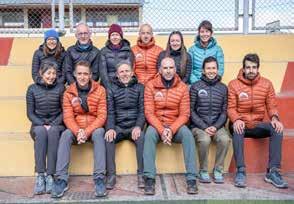
MOUNTAIN PLANET 2024 33 DR DR DR
INNOVATION
Effort test in simulated altitude.
Samuel Vergès (2nd from bottom left) and the team of scientists from Expedition 5300.
Innovation in the air...
Billions of people worldwide lack access to clean drinking water1 and rely on bottled water, which is expensive and environmentally harmful. Recognizing this, Luc Métivier teamed up with an inventor, an expert in air drying at nuclear power plants, who developed a system similar to a photovoltaic panel called the SunAir Fountain.
“The panel captures moisture from the air at night and fixes this moisture onto an adsorbent. The next day, when the sun hits the panels, the molecules transform into water vapor under the colder panel glass, causing condensation,” explains Luc Métivier.
BY VÉRONIQUE PILON
Entirely designed and manufactured in France, lightweight, and assembled in 30 minutes, a panel measuring 0.7 x 1.1 m produces 1 liter of water per day. “It’s pure water,” specifies Luc Métivier. “Laboratory tests show no PFAS, bisphenol, or microplastics. There are two types of filters that prevent particles from passing, then the adsorbent, in the form of micro-porous beads, captures only water molecules. Finally, there’s an active carbon filter at the water outlet. What’s left is just the water and minerals.”
A Very Promising Future
“Our product will interest all countries experiencing significant water stress, where people don’t have access to potable water, or where tap water is unreliable. We are targeting Southern Europe, especially since we are supported at the European level, but also North Africa, where water scarcity is a cause of rural exodus. Another market is the Middle East, with its high nocturnal humidity and significant sunlight during the day. For our panel, it’s paradise!”
A cubic kilometer of atmospheric air contains the equivalent of six Olympic swimming pools, or 15,000 m³.
Another application area is the agri-food industry, which uses filtered and sterilized tap water, a lengthy and expensive process. The agricultural market is also being researched in partnership with French startups to develop greenhouses watered by the panels.
An unexpected market, the mountain regions, could benefit from this innovation.
“We have had several requests from Switzerland, Haute-Savoie, and the south of France, where some water sources dry up, at least during the summer months. With the panels, we recreate a mini-source
MOUNTAIN PLANET 2024 34
2
INNOVATION

for animals or wildlife. The solution could also be interesting for small alpine chalets, eco-lodges, and shelters...”
Agua De Sol has already started producing pre-series that have been tested in France, the United Arab Emirates, Tunisia, and Greece. “These tests allowed us to improve the panel, whose final version will be produced starting in June.”
Supported by Europe, its French partners, NGOs, and institutions, the company already has orders and numerous projects in different countries.


Agua-de-sol.com

MOUNTAIN PLANET 2024 35
FOX RADAR
FOX RADAR
PEXELS-LUMN
INNOVATION
A single panel measuring 0.7 x 1.1 m produces 1 liter of water per day.
SOCIALLY YOURS
SENIORS ON THE MOVE!
BY VÉRONIQUE PILON
Founded in 2022, Alter-Native brings together five partners, a group of people in their forties and fifties from different backgrounds such as development, real estate management, or architecture.
“After having worked together in our previous professional lives, we embarked on a project with a common goal: bring meaning to what we do!” says
Philippe Colleu, Director of Operations and partner. Alter-Native’s success story offers a new format of shared living for “new generation retirees” who are independent and seek new accommodation solutions to fully and actively enjoy their freedom.
Rock the Kasbah
“When you’re still in good shape, you can’t see yourself in a ‘senior’ residence, but that doesn’t mean you’re not anticipating aging and future housing needs. To try and change perceptions, we’ve given our concept a bit of a rock ‘n’ roll identity. We’re targeting a counterculture generation that does not see aging the same way previous generations did. We claim this rock ‘n’ roll vibe for our clientele and also in our services,” continues Philippe Colleu. The concept is indeed unique, with small residences, 15 to 20 spacious, independently equipped apartments with rock ‘n’ cozy decor, a shared space designed like a bistro, and carefully selected locations that are both peaceful and close to all amenities. “Because we build small places, we can more easily fit into city centers, villages, residential areas.”
By 2050, over a third of the population will be over 60 years old. Beyond the numbers, a true sociological and cultural revolution is underway: the “Rolling Stones” generation, Baby Boomers, Generation X... Today’s (and tomorrow’s) seniors are diverse, with new, evolving, varied, and multiple needs that have led to a new real estate offering soon to be found in the mountains.
Freedom
The housing will be offered for purchase or rent, furnished or unfurnished, with standard but adaptable equipment according to the residents’ needs. The concept is based on the total independence of seniors who have their own apartment but can share moments and activities. Alter-Native organizes events that break the mold: concerts or artistic workshops, gastronomy, outings...Everything is optional, of course, but aimed at creating connections and meeting the needs of these hyperactive and epicurean retirees. The company also offers a range of concierge services on demand.
Rock ‘n’ Roll Altitude
Alter-Native is based in Grenoble and aims to establish its housing in the Isère, Savoie, Haute-Savoie, Rhône, and Ain regions. “We focus on peri-urban or even rural areas as long as the town hall is concerned with senior issues, but we’re also interested in year-round village resorts like La Clusaz or Chamonix, or valley towns that support resorts, like Bourg d’Oisans or Bourg SaintMaurice. There are solutions to be found for mountain territories. We were confirmed in our positioning when we visited the Vercors, which is currently reflecting politically on ‘aging well.’ They were very attentive to our concept.”
MOUNTAIN PLANET 2024 36
INNOVATION
There are solutions to be found for mountain territories. We were confirmed in our positioning when we visited the Vercors, which is currently reflecting politically on ‘aging well’.
Why Not Seasonal Stays?
In some residences, Alter-Native will offer an apartment for a test or temporary stay, for a convalescence period, for example. “In mountain territories, we are considering integrating a seasonal stay offer, aimed at long-standing senior clients, for whom mountain stays are becoming increasingly complicated (access, snow removal, stewardship...) These clients could mingle with the year-round occupants, creating bonds and new stories to tell. We have the flexibility to adapt our model, which is not completely fixed. In the territory we have defined, there are many different cases, expectations, and needs; we already have a lot to do!” The marketing of the first apartments starts for a series of housing that will be delivered next year in Grenoble.
Alter-native.site




MOUNTAIN PLANET 2024 37 ALTER-NATIVE ALTER-NATIVE ALTER-NATIVE
INNOVATION
TRANSITION
AMONG THE 71 COUNTRIES
REPRESENTED AT THE TRADE SHOW, MANY BRANDS ARE TAKING ACTION WITH RESORTS TO REVISE THEIR APPROACH TO ENERGY, ENVIRONMENTAL, AND SOCIAL ISSUES.
BY MARIE-FRANCE SARRAZIN AND CLAUDE BORRANI


MOUNTAIN PLANET 2024 38 BAILLON-HENRION ARCHITECTES
The Sport Innovation Center spans 1100 m² over two levels.
IN LES ORRES, THE BET ON VIRTUAL REALITY TO CONVERT USERS TO PRACTISING MOUNTAIN SPORTS IN REALITY
The Les Orres resort has just opened a facility “without equivalent in the world,” according to the mayor, Pierre Vollaire. It marks the first step in its project to create an experiential resort aimed at promoting outdoor sports, reclaiming young people and audiences who perceive mountain activities as inaccessible or unattractive. The ultimate goal is to convert them to the real practice of mountain sports through virtual reality. At 1650 meters, the Sport Innovation Center spans 1100 square meters over two levels. It offers visitors the chance to experience intense sensations without any risks in skiing, mountain biking, paragliding, kayaking, speedriding, and speedflying through simulators. The footage was shot in the region by drone. An indoor inclined ski treadmill is intended for both beginners and high-level athletes who can thus train, even off-season, and analyze their performance thanks to video and sensors. Additional training equipment focused on new boardsports might be installed, especially as these disciplines will be featured in the 2030 Olympic Games in the French Alps.
This €5.2 million investment will be complemented by a second one in 2026, estimated at €10 million: a Future Mountain pole located at 1800 meters. It will include other simulators on new boardsports and revolve around immersive mountain imagery, “like in a geode.”
The resort has organized the Ocova forum every year for 20 years, where the mountain of tomorrow is envisioned by presenting the latest innovations for territorial development. In the same spirit, the Future Mountain pole aims to be an information hub for young people and families about the virtuous, smart, and transitioning mountain through technology and artificial intelligence.

Did you know?
Avoriaz has installed a 2000 KW wood-fired heating plant that serves the aquatic center and more than 400 accommodations.
The resort has also invested in financing a micro-hydroelectric plant and has chosen green energy for its tourist office, golf course, and indoor sports hall.
31%
This is the proportion of housing in resorts classified as F or G, double that of all French municipalities combined. Adding the 37% of E-rated properties, over two-thirds of the accommodations could be banned from rental due to tightening regulations.
Source Fnaim – November 2023


MOUNTAIN PLANET 2024 39
TRANSITION
Mass Renovation of Condominiums
Legislative and fiscal changes are about to hit the French resort real estate market hard, including plans to extend the ban on thermal sieves to furnished tourist rentals, reduce the tax advantage from 71% to 30%, and apply a usage servitude to preserve land for primary residences.
In this context, renovating tourist accommodation in resorts is becoming a major lever. To accelerate this, priority must be given to condominiums or tourist residences, the bulk of the real estate stock, believes Sylvain Charlot, mountain delegate at Atout France, who insists that rehabilitation must be comprehensive and exemplary.
Atout France, in partnership with the Banque des Territoires, supports 50 resorts over 5 years in renovating their real estate as part of the Future Mountains Engineering program. Twenty-five resorts, representing 513,000 tourist beds, were selected in the first wave, expiring at the end of the year. “We are in the operational, the concrete with the aim of massifying this requalification. We do detailed work. Renovation of furnished apartments is not our main focus since 80% of energy savings come from common areas. The focus is on the envelope, the hot water and heating production system, ventilation.”
Atout France supports 13 condominiums in 10 resorts with project management assistance. They can be very large, like in Villard-de-Lans or the Grand Tourmalet, or smaller, like in PeiseyNancroix. “For small complexes, we test setups like Rénovacime, consisting of intervening only with bio-sourced materials and 100% wood prefabrication.” Atout France develops tools for information and characterization of the inventory, analysis of economic and fiscal impacts, and return on investment times. Financing remains the biggest obstacle, especially since legislators seem reluctant to extend renovation aids to secondary residences. “We are exploring the possibility of emerging collective loans or third-party investors.”

Did you know?
A ski area’s activity represents 3% of the carbon footprint of a ski day, while transportation accounts for 52%, accommodations 21%, clothing, ski equipment, and leisure activities 16%, and food 8%.
(Source: Ademe study on GHG emissions, sector guide 2022)
MOUNTAIN PLANET 2024 40
TRANSITION
Map of the first 32 projects selected as part of the Future Mountains Engineering program

Compagnie des Alpes Launches its Think Tank
To respond to ecological, economic, and social challenges in the mountains and build a sustainable and desirable future for the massifs and their inhabitants, Compagnie des Alpes has created the Lab Changeons d’ère by CDA. This multidisciplinary think tank brings together six people to reflect on the evolutions of the French mountains in their social, economic, environmental, sociological, and demographic components with the aim to act, innovate, and find solutions. It includes Jean-Laurent Cassely (lifestyle and territorial issues specialist), Sylvain Coutterand (glaciology enthusiast), Emmanuelle Duez (founder of a consulting firm, future of work observatory), trade unionist Jean-Claude Mailly, Philippe Moati (economist, specialist in commerce and consumption) and Clémence Perrin-Malterre (sociologist, specialist in the tourist diversification of mid-mountain territories and the evolution of professional practices of sports providers). This Lab met for the first time on November 29 last year and will regularly report on its work.

GOVERNANCE: POOLING AND COMPLEMENTARITY IN GRÉSIVAUDAN RESORTS
Since 2017, the mountain resorts of Col de Marcieu, Collet d’Allevard, and Les 7 Laux have been managed by the Grésivaudan community of municipalities. In 2021, the Grésivaudan elected officials undertook a total overhaul of the governance modalities of these three sites, which were previously managed independently. Since December 7, 2022, therefore, there is a single operator at the head of these resorts: the Grésivaudan Mountain and Leisure Exploitation Company.
Grésivaudan is betting on the complementarity of their offer: Col de Marcieu for a first contact with the mountain, Le Collet d’Allevard for learning, and Les 7 Laux for the more experienced.
This is just the beginning. The possibilities for pooling and complementarities are numerous. The community can consider a transition strategy on a territorial scale through a global and multi-thematic approach (ski area, activity offers, mobility and access, urban planning and public services, tourist accommodation, environment...). The operator can pool seasonal jobs across the three sites, thus securing contracts. The user, in turn, benefits from a varied, multi-site offer both summer and winter, and an alternative, should snow be lacking in one of the domains.
Did you know?
In the energy mix, a new player is making its entrance: hydrogen. Snow groomers and hydrogen buses are being tested at Les Grandes Rousses and Alpe d’Huez.
MOUNTAIN PLANET 2024 41 DR DR

DEVELOPMENT
INDIA BELIEVES IN ROPEWAY TRANSPORTATION
LES SYBELLES AIM FOR CARBON NEUTRALITY BY 2037
Among the flagship actions implemented, since 2019, 100% of the energy used by the ski lifts and installations of the ski area is produced from renewable energies thanks to a green contract signed with EDF. Snow grooming machines, drivers, and sat scans accurately informing of the snow cover have reduced the number of grooming hours by 21%. And the area succeeds in producing 20% less artificial snow thanks to digital tools. “We have fauna-flora observatories. Not a project goes ahead without taking biodiversity into account and if there’s an issue, we stop it,” adds Samuel Leroux, general manager of the ski area.
During the first symposium on ropeway transportation held in New Delhi in February 2024, Indian Transport Minister Nitin Gadkari confirmed his country’s significant interest in this mobility model. By submitting no fewer than 350 projects to a state-owned infrastructure company under the “Parvatmala Pariyojana”—the national ropeway development program—India has cemented the notion that ropeways will be a preferred and environmentally sustainable alternative to conventional roads in challenging mountain areas. Regions such as Himachal Pradesh, Uttarakhand, Jammu & Kashmir, and the Northeast are involved in these projects, which will naturally span several years and, as of this year, will merit a visit by an Indian delegation to the Mountain Planet expo.

POMA began its journey in India 30 years ago with the Gulmarg gondola lift, and continues today with projects like Balheydunga and Pelling.
MOUNTAIN PLANET 2024 42
DR TRANSITION
LES SYBELLES



Pos ive Impact



modèle Féminin
Isol ion
ADAPTEZ-VOTRE TENUE À VOTRE BESOIN DU MOMENT
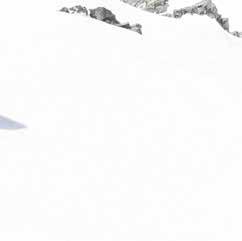

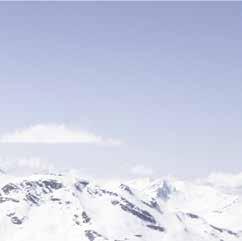


Résistance
Protection




Confort
CHOISIR SON ISOLATION C’EST POSSIBLE !
DES SYSTÈMES DE FIXATION INVISIBLES PERMETTANT DE SOLIDARISER LES DOUBLURES
THERMIQUES AUX PARKAS EN FONCTION DE VOS BESOINS


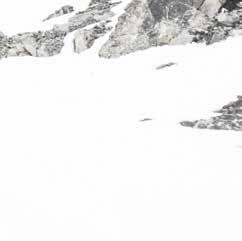



LE CONCEPT INTEMPÉRIES
A DÉCOUVRIR SUR CEPOVETT-SAFETY.COM @cepovettsafety cepovettsafety cepovettsafety cepovettsafety Suivez-nous !
MAGIC RECIPE?
The Spanish ski area La Molina, facing a lack of snow, is increasingly relying on artificial snowmaking. Over the next three years, this Pyrenees station will test a new, less resource-intensive technique capable of producing snow at higher temperatures. Named Slow laboratory and led by the Institute of Materials Science at the University of Barcelona, the project mimics a process that occurs in clouds called ice nucleation: ice forms in the atmosphere from water droplets. But they can remain liquid even at temperatures as low as -38°. A few years ago, scientist Albert Verdaguer discovered that feldspar, a mineral, could accelerate the freezing of water droplets at temperatures close to 0°. Lab tests proved that when mixed with water, this mineral allowed for snow production at temperatures 1.5° higher than the traditional method, while reducing energy costs by about 30%. Moreover, the conversion ratio (the volume exiting the snow cannon compared to the amount of water entering) is improved. While traditionally at 75%, it could climb to 90%. This would significantly reduce losses.
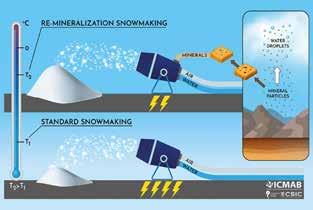

(SMALL) FOSSIL FUEL-FREE STATION
Becoming a ski resort without fossil energy by betting on electric solutions is the challenge of Hammarbybacken, located in Stockholm, in partnership with the Volvo Group. An L25 electric wheel loader and a PU500 power unit, and a battery storage system with an integrated charger, join electric snowmobiles and snow groomers in this area operated by SkiStar. This equipment will be tested until the end of the season to understand their operation and provide valuable information for their use in other ski resorts. The Volvo Group had already worked with SkiStar last summer in Sälen, to achieve a zero-emission construction.

MOUNTAIN PLANET 2024 44 VOLVO TRANSITION
Illustration of the feldspar phenomenon, a mineral that can accelerate the freezing of water droplets at temperatures close to 0°

ÉTRAVE FRAISE À NEIGE BALAYEUSE ÉPANDEUR ARIENS MAMMOTH EN ACTION www.ariens.eu

After Climsnow, Here Comes Clim’eau
Climsnow marked a turning point in the prospective management of ski areas, relying on a scientific analysis of snowfall, resort by resort, slope by slope, at various deadlines, according to several parameters and more or less disastrous scenarios linked to climate change. This study, carried out by a scientific consortium composed of Météo France, Dianeige, and Inrae, has helped guide operators in their investment choices—but also to justify the granting or not of public subsidies.
In 2021, the Provence-Alpes-Côte d’Azur Region commissioned a study covering 31 ski areas and 44 alpine and Nordic ski sites in the Southern Alps. It now seeks to complement the Climsnow modeling with a hydrological modeling in the form of maps and commentary. The conclusions of this in-depth study, carried out over 14 months and named Clim’eau, should be known by mid-2025. The challenge is to understand the impacts of artificial snow production, whose needs will be increasing, on the local water resource and the associated aquatic environments. Impacts that are measured on a regional scale, while mountain water serves both for drinking water supply, irrigation, energy production, and leisure. Tensions related to water sharing were particularly felt during the drought episode of 2022, and the investments related to it (mega-basins or hill reservoir projects) are equally thorny issues. “It’s about assessing the acceptability of these impacts and guiding public expenditures,” adds Niels Ginestou, head of mountain and alpine massif service at the South Region.
Each resort will obtain its own water resource knowledge map and its evolutions according to different climate change scenarios. “We aim to provide resorts with scientific security, so they know at different horizons what type of resource they can count on, to adjust their strategy related to artificial snow production and possibly make the right investments to compensate for the lack of water resources. Beyond that, it allows for a tool to encourage dialogue with users in the territories because it’s an extremely sensitive subject,” reports Niels Ginestou.
CONVERSION TO BIOFUELS
Green systems automotives offers the possibility to decarbonize fleets immediately for a reasonable cost, and without having to change the entire fleet at once. This Aix-en-Provence start-up installs a box on motorized two-wheelers, leisure vehicles, and pleasure boats that allows engines to run on biofuels, without impacting their performance. This system promises a 70% reduction in greenhouse gas emissions and a 50% reduction in fuel costs. A solution for snowmobiles, quads, and ski area maintenance vehicles. “Less than 2% of agricultural land in France allows the fleet, estimated at more than 300,000 vehicles, to operate. The sector is renewing and we are working on the emergence of biofuels from algae or residues from the wood industry,” says CEO Olivier Barts.
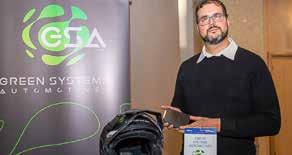
Did you know?
The snow groomers in the Les Arcs-Peisey-Vallandry area use 100% renewable fuel, HVO100. Undoubtedly one of the factors that made this area the first in Europe to receive the B Corp certification.
MOUNTAIN PLANET 2024 46 RARM DR
Olivier Barts, founder of the Aix-en-Provence start-up at CES Las Vegas where it was awarded for its converter box that adapts two-wheelers to biofuel
TRANSITION
Elevating to Renovate
It’s both a way to create occupied beds and renovate energy sieves. The young Savoyard company Level Up, based in Belleville, takes charge of the energy renovation of energy-guzzling mountain condominiums in exchange for the cession of the right to add floors to build new apartments on their roof. It finances itself exclusively by marketing these additional square meters. “What motivated us is to act in favor of the carbon footprint of a ski stay. After transport, lodging is the second largest emitter of greenhouse gases,” recalls Grégoire Chavanel, founder of Level Up alongside his partner, Stéphane Albrecht. Both are from the mountains.
This solution allows these energy-guzzling condominiums, often built between the 1960s and 1980s, to have a nice envelope, leaving them with a residual cost, to carry out regulatory works all the more costly as these assets are not eligible for state subsidies, reserved for buildings comprising more than 75% primary residences. The improvements undertaken concern the building’s envelope, its heating mode, sometimes its joinery, the insulation of its roof and floor. Obviously, not all buildings can lend themselves to this system, which depends on what the local urban plan provides, the available roof space, and the building’s capacity to accommodate new loads. “Beyond two additional floors, structural reinforcements must be added, which increases the cost,” says the director. The company favors the use of wood, lighter and with a favorable carbon footprint, to build its extension. For the operation to be profitable for both parties, Level Up must be able to count on a sale price of at least €6000 to €7000 per square meter, which can also limit its field of intervention.

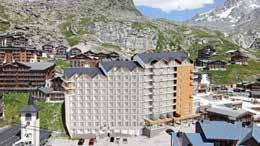

ELECTRIC SNOW GROOMERS: CDA STEPS UP
For several years, Compagnie des Alpes has collaborated with CM Dupon, a family-owned Alpine company and the only French manufacturer of snow groomers, to launch several experimental projects aimed at developing a lowcarbon snow groomer. Tests on prototypes of electric snow groomers were conducted in La Plagne and Tignes: the performances in terms of consumption and autonomy (5h30/6 hours) were conclusive. The group has therefore decided to order eight pre-series of electric snow groomers for operational use, including two during the core of the 2023/2024 season and six over the winter of 2024-2025 across all its areas, starting with Serre Chevalier. Using these machines only requires a slight adjustment of the work conditions for the groomers. The group aims to transition its current fleet of 140 snow groomers to electric. The device allows an average saving of 80 tons of CO2 equivalent per year per snow groomer and eliminates hydraulic fluids.
He said
“Compagnie des Alpes concretely deploys the means to achieve its net zero carbon goal without wasting time. In doing so, we follow the line of the ‘10 commitments and 5 renunciations’ announced last June by encouraging and supporting research and the development of new solutions and, when these demonstrate their effectiveness, accelerating their implementation to deploy them massively on the ground. Furthermore, we aim to favor local players and thus participate in the reindustrialization, notably decarbonized, of the territories where we are located.”
Dominique Thillaud, General Manager of CDA
MOUNTAIN PLANET 2024 47 DR TRANSITION
TRANSITION
He said
“We are working towards the complete decarbonization of our machines by 2030. Today, we have snow groomers that operate on vegetable fuels. They emit less CO2, but biofuel remains very expensive.
Innovations are underway in electric, hybrid, or hydrogen technologies. We must move in this direction. Developing zero-emission snow groomers is a goal, but the infrastructure, especially for charging, must also be established in the resorts. Not everything depends on us, and it takes time. Everyone must discuss these issues and be united in implementing a common project.”
Gilles Fournier, new General Manager of Kässbohrer France
Did you know?
In municipalities hosting medium to large ski areas, state grants usually represent only 5 to 20% of the community’s revenue, compared to 50 to 80% for municipalities with the same permanent population but no winter sports station.
85%
LOW-CARBON ANTI-SLIP LOORING
The Savoyard company IDM, a specialist in spare parts for ski area infrastructures, has launched its Ecovertis label to reduce CO2 emissions and promote the circular economy. Previously, rubber linings for ski lifts were incinerated at the end of their life cycle, after five years. Meanwhile, the anti-slip flooring used on many facilities were shipped by cargo from Asia.

With Ecovertis, the linings are no longer incinerated but are repurposed by companies in Auvergne-Rhône-Alpes, transformed into Ecoverclip anti-slip tiles, made of 75% recycled material. This innovation prevents the incineration of 80 tons of linings and cuts in half the transport of flooring from Asia.
This is the percentage of skiers who travel to resorts by car, versus 10% by train, according to a study commissioned by the association Protect Our Winters (POW). From this observation was born POW mobility, a door-to-door multimodal transport reservation service to reach the ski resorts of Savoie and Haute-Savoie. Users can create their journey combining bus, train, taxi, vehicle rental... and pay, via the site, in one go.
To guide their choice, they can access the CO2 emissions generated by each mode of transport.

MOUNTAIN PLANET 2024 48 POW MOBILITY
Source: Mountain Cluster trend book / Nicolas Savelli, Head of Management Modes at Stratorial
He said
“New real estate operations in the mountains must be seen as exceptions in response to the real and substantiated needs of the destination, and which cannot be met by the existing stock.”
Sylvain Charlot, Mountain Delegate at Atout France
The Flip Side of Four-Season Tourism
“Climate change and rising temperatures have a direct effect on winter and summer tourism: the mountain’s appeal as a cool refuge in summer, a decrease in ski resort attendance, and a shortened ski season. The diversification of tourism and the development of four-season tourism or mountain resorts rather than ski resorts remain one of the main priorities in the countries studied (France, Italy, Spain, Austria, Romania, Slovenia, editors note). While year-round tourism development offers opportunities for mountain regions, it can also generate negative externalities: development of outdoor activities in protected spaces or areas that previously rested for six months of the year, or massive vehicle flows in natural areas.”
Source: ANCT study “European Perspectives on Member States’ Policies against Climate Change in the Mountains,” 2023
100% Recycled and Recyclable Signposts
The Savoyard signage company Sunconseil has committed to no longer using raw materials from fossil sources in its production of trail signage or pathways by 2030. It plans to achieve this through a new material, Réo mat, made from post-consumer or post-industrial plastic waste without the addition of resin. This material is UV resistant, easy to print and machine, and withstands moisture and heat up to 120°C. It is thermoformable and water-repellent. The customized signposts, using vegetable inks, are 100% recycled and recyclable. Result: the equivalent of 0.5 kg of CO2 is avoided for each signpost, amounting to an average of 12.5 kg of CO2 for an entire trail, and 57 km of road.
80%
This is the percentage of tourist beds in resorts coming from second homes, mostly in condominiums, aged 30 years or more.
Source: Mountain Cluster trend bookSylvain Charlot, mountain delegate at Atout France
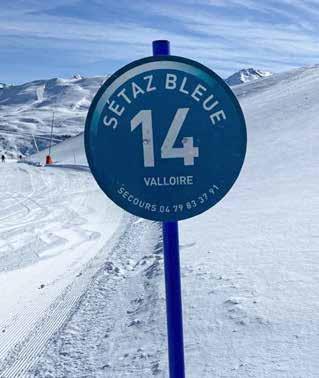

MOUNTAIN PLANET 2024 49 DR TRANSITION
THE SECOND LIFE OF WASTEWATER
In the United States, it’s possible to use wastewater to produce artificial snow, thus avoiding drawing water from natural environments. The most recent example is Big Sky, Montana. Its treated wastewater feeds the snowmakers of the nearby Yellowstone Club ski resort and irrigates neighboring golf courses. However, opponents criticize the initiative, citing a study showing the presence of medication residues in the treated water. Pollutants that could impact downstream fauna and flora.
HOW TO ADDRESS OVERCROWDING OF NATURAL SITES?
Victim to the social media effect, the natural site of Trolltunga (troll’s tongue) in Norway, accessible by a 22 km loop trail through the mountains, went from 1,000 visitors in 2009 to 75,000 in 2016. Indeed, these tourists have boosted the local economy, but the site was not equipped to handle such a flow, especially inexperienced hikers. The Hordaland County Council joined the Interreg Ascent project, conducted from 2016 to 2018, alongside Scotland and Ireland, facing the same problem.
Various measures were implemented to limit the hikers’ impact on the natural site. Sections of the trail were restored: some parts were suffering from severe erosion due to trampling, others had become too narrow to accommodate so many hikers, leading some to stray from the path, with consequences for local ecosystems. Actions were complemented by drainage, planting of local species, and directing visitors. Educational panels were placed along the trail to raise hikers’ awareness of the impact of human waste on the ecosystem.
An emergency shelter and mountain guides were stationed on the trail in 2017 to respond to an increase in accidents at the site, reaching 40 interventions in the summer of 2016, a heavy burden for local Red Cross volunteers. The following summer, the number of rescues dropped to 15. Why? Because these guides identify visitors who are poorly equipped or start the route too late in the day and advise them to turn back. Communication materials, translated into several languages, help hikers prepare for their visit.
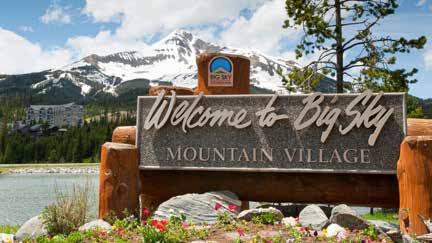

MOUNTAIN PLANET 2024 50
DR
BIG SKY
TRANSITION
How to Address Overcrowding of Natural Sites?
Victim to the social media effect, the natural site of Trolltunga (troll’s tongue) in Norway, accessible by a 22 km loop trail through the mountains, went from 1,000 visitors in 2009 to 75,000 in 2016. Indeed, these tourists have boosted the local economy, but the site was not equipped to handle such a flow, especially inexperienced hikers. The Hordaland County Council joined the Interreg Ascent project, conducted from 2016 to 2018, alongside Scotland and Ireland, facing the same problem. Various measures were implemented to limit the hikers’ impact on the natural site. Sections of the trail were restored: some parts were suffering from severe erosion due to trampling, others had become too narrow to accommodate so many hikers, leading some to stray from the path, with consequences for local ecosystems. Actions were complemented by drainage, planting of local species, and directing visitors. Educational panels were placed along the trail to raise hikers’ awareness of the impact of human waste on the ecosystem. An emergency shelter and mountain guides were stationed on the trail in 2017 to respond to an increase in accidents at the site, reaching 40 interventions in the summer of 2016, a heavy burden for local Red Cross volunteers. The following summer, the number of rescues dropped to 15. Why? Because these guides identify visitors who are poorly equipped or start the route too late in the day and advise them to turn back. Communication materials, translated into several languages, help hikers prepare for their visit.
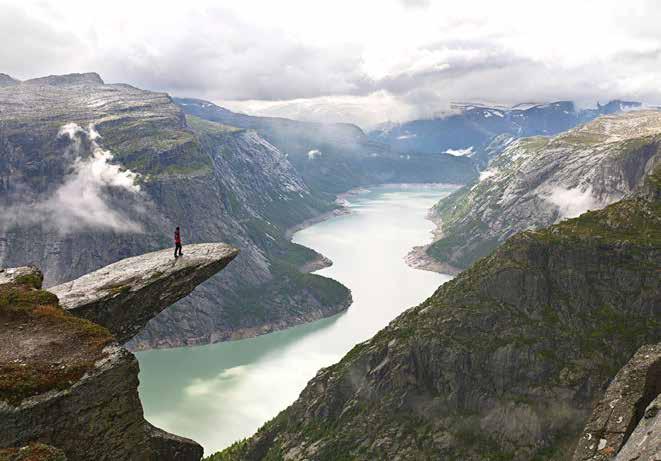
MOUNTAIN PLANET 2024 51 TROLLTUNGA
TRANSITION
Serre Chevalier, The Pioneer, Embraces Circular Economy
After focusing on energy efficiency and production, the high-Alpine resort is tackling another aspect of environmental transition by revising its consumption policy.
BY MARIE-FRANCE SARRAZIN
Initially, some may have seen him as a visionary or dreamer. Now, everyone is eagerly anticipating his next achievement. In 2017, Patrick Arnaud, General Manager of Serre Chevalier Vallée (SCV Compagnie des Alpes), set out to meet 30% of the ski area’s electricity needs by 2023, utilizing wind, solar, and hydroelectric power, based on the idea that a ski resort is a highly favorable environment for renewable energy production.
This challenge has been met and even exceeded, thanks to significant reductions in consumption.
85% of the energy produced comes from hydroelectricity, through the installation of two turbines, 12% from photovoltaic panels, and 3% from two small wind turbines. “The initial plan was to install more wind turbines, but their implementation cost is high relative to the energy produced, and there is a visual impact... However, we installed more photovoltaic panels than planned,” notes Mr. Arnaud.
“Every kWh Counts”
Meanwhile, the resort has embarked on an extensive energy efficiency plan, reducing consumption by 20%.
“We have to go into detail, chase every kWh.” This meticulous approach starts with a precise audit, using sub-meters. Surprisingly, a third of the energy consumed is from tertiary sources, including heating for cabins and the 13 non-freezing machine rooms set at 8°C. Staff awareness combined with a plan to insulate all buildings, starting with the most energy-intensive, has been effective.
SCV then tackled artificial snow production, cutting it by 20%. “We used to pass at least 700,000 m³ of water per year. For the past four years, we’ve been between 450,000 and 600,000 m³ per year depending on the weather.”
How? By doing some summer trail work, refining snow production statistics for each trail and snowmaker (of which there are 700). “It’s surgical,» observes the operator.
Again, management plays a key role. The snow production, grooming, and trail services are now united under one entity, which wasn’t the case before: “Snow production used to be the sum of three separate requests.”
Last year, the resort acquired a drone that scans the domain every four days, equipped with a LiDAR sensor that accurately measures snow depths on each trail. This tool objectively assesses the situation, identifying areas with significant snow reserves for better distribution. “Next year, we plan to automate artificial snow production based on drone data using artificial intelligence,” announces the General Manager. He also considers calculating the amount of snow produced to last the final days of the season. “Our motto is: it’s better to adapt than fight.” Adapting means anticipating climate change and sizing future equipment accordingly. For example, the new Pontillas gondola arrives at a location that could become a high-altitude snow front in the future, reducing reliance on artificial snow.
“Another 10 to 15% Savings Possible”
Slowing down ski lifts has been beneficial for when attendance is low. “Going from 5 to 4 m/s means an overall journey time increase of just one minute, almost imperceptible to users, but a 20% reduction in consumption is quite tangible for us.”
In terms of production, SCV believes it has little room for improvement, with only a few more roofs to equip. In terms of efficiency, Patrick Arnaud estimates a
MOUNTAIN PLANET 2024 52
TRANSITION
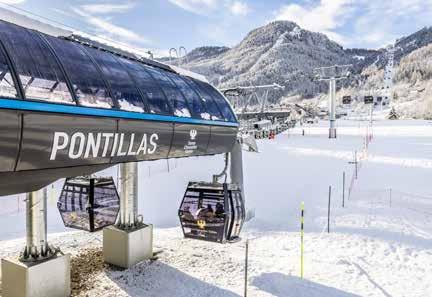

potential for another 10 to 15% savings by focusing on artificial snow and tertiary consumption. “We’ve done what we said we would, and we’re extremely proud. My team shares the same values.”
Repair, Reuse, Purchase Only What’s Necessary
And now? A new adventure is on the horizon. SCV is addressing another dimension of environmental transition by embarking on a circular economy approach to preserve natural resources. Consuming the least amount of raw materials possible, buying only what’s strictly necessary, repairing, and reusing because “recycling is already a failure.” It’s common sense, even if it costs the same or more and requires more effort. This policy has been in place at Serre Chevalier for several years but will now be accelerated and expanded, with the help of a specialized company and the circular economy development association SoluCir. In 2019, the renewal of the Cibouït chairlift was achieved by reusing the old Eychauda chairlift, retrofitted for the occasion. Similarly, many components of the old Pontillas gondola were preserved for future use: sheet metal for cabins, steel beams for concrete slabs...
Snow groomers, too, have long been retrofitted, replacing only defective parts.
“We have to go into detail, chase every kWh.”
“This summer, instead of discarding all the markers that were no longer in good condition, we only threw away those that were broken; the rest were repainted. It had reached a point where it was easier to buy new ones than to repaint them,” explains Patrick Arnaud.
Just as with the implementation of the energy efficiency plan, SCV is now precisely analyzing what it purchases in quantity each year before establishing a purchasing strategy. How to ensure a lower turnover rate? By asking employees to take better care of the equipment and by purchasing French or European products, which are more expensive but also more durable and repairable. “Price becomes a secondary factor in purchasing, whereas it used to be the main argument.”
This significant project will be closely monitored by other stations and it’s highly likely they will take inspiration from it.

MOUNTAIN PLANET 2024 53
THIBAUT BLAIS
THIBAUT BLAIS
TRANSITION
Serre Chevalier adapts its investments to climate change. The new Pontillas gondola reaches a location that could become a highaltitude snow front in the future.
ANMSM Creates a Best Practices Platform
Each ski resort contributes to building a more sustainable mountain environment at its own level. Pierre Vollaire, mayor of Les Orres (Hautes Alpes) and president of the ANMSM’s Sustainable Peaks Commission, highlights three examples of initiatives in mobility, waste management, and energy, among many others.
BY MARIE-FRANCE SARRAZIN
The National Association of Elected Officials in Mountainous Regions (ANMSM), through its Sustainable Peaks Commission, has established a platform on its website showcasing best practices for sustainable development in ski resorts. The goal is to inspire others to accelerate the transition.
Fewer Shuttles at Courchevel
Following its mobility and transport scheme, analyzing the needs and behaviors of seasonal workers, vacationers, and residents, Courchevel (Savoie, France) decided to fund ropeway connections during the winter season. The operating hours of the ski lifts, connecting the bottom and top of the resort, are now extended, running from 7:45 am to 11:30 pm. This has resulted in fewer vehicles on the roads, reduced greenhouse gas emissions, and a shortened travel time to six minutes to go from 1300 m to 1850 m. There were 140,000 trips recorded, 90% of which were concentrated between 7:45-8:45 am and 4:45-7:45 pm, equivalent to saving 2,000 shuttles with a capacity of 70 people each.
KEY FIGURES
2,000 70-person shuttles
This is the reduction achieved by Courchevel following its mobility and transport scheme.
No More Discarded Skis in Chamrousse
While ski equipment recycling is now widespread across all mountain ranges, the resort of Chamrousse (Isère) was a pioneer in this field. Annually, the Savoyard company Tri-Vallées collects used equipment from ski rental businesses for subsequent repurposing. Each business pays based on the amount of equipment handed over, at 1€ per pair of skis and shoes and 30 cents for helmets, fulfilling the legal obligation to finance waste removal.
Chamrousse has partnered with the neighboring city of Prapoutel to share transport costs. The municipality coordinates the operation and covers the cost of promotion.
Nationally, ANMSM collaborates with the recycling firm Ecologic: 42 collection points have been established, including 35 in the Alps, 5 in the Pyrenees, 1 in the Massif Central, and 1 in the Jura. These are open to individuals, clubs, communities, and professionals. In 2022, Ecologic collected 40 tonnes experimentally and 165 tonnes in 2023.
In the Serre-Ponçon valley in the Hautes-Alpes, during the 2022-2023 season, 2.9 tonnes were recovered from the resorts of Les Orres, Crévoux, and Réallon. About ten pairs of skis and twenty pairs of shoes were collected for resale in resource centers, with the remainder, 2.81 tonnes, sent for recycling. This initiative will be repeated this winter.
KEY FIGURES
42 collection points established by the recycling firm Ecologic, including 35 in the Alps, 5 in the Pyrénées, 1 in the Massif central, and 1 in the Jura.
165 tonnes of equipment were collected in 2023
MOUNTAIN PLANET 2024 54
TRANSITION


In winter, the ski lifts operate over an extended timetable to reduce the number of vehicles on the roads.
Artificial Intelligence at Les Orres
Pierre Vollaire has turned the Les Orres resort into a laboratory for economic and energy transition, organizing the annual Ocova forum where the latest innovations for mountain territory management are detailed.
The town itself tests these innovations. It implemented an energy management system using sensors and data to gain insights into the consumption of ski lifts and buildings, reducing it by 20%. This saving reaches 50% for public lighting. Veolia’s water resource management is also optimized with the installation of 750 smart meters. Various stakeholders working for the town (Semlore, Territoire d’énergie 05, Gaz et électricité de Grenoble...) will exchange data through the company Atos to further reduce consumption and use energy in a closed loop.
By the end of the year, with the installation of a hydroelectric plant, the town will produce over 4 GWh per year, equivalent to the entire consumption of Semlore, the ski lift company that also manages the
ice rink, tourist office, and cinema. By 2026, with a photovoltaic canopy over a parking area, an additional half GWh per year will be generated.
KEY FIGURES
20%
This is the energy saving achieved by the Les Orres resort for ski lifts and buildings through the installation of smart sensors. A 50% saving in public lighting.
750 smart meters
will now contribute to optimized water resource management at the resort by Veolia.
MOUNTAIN PLANET 2024 55
MFS
MFS
TRANSITION
Pierre Vollaire, mayor of Les Orres, is chairman of the ANMSM’s Sustainable Peaks Commission.
A Decarbonized Mountain in Motion
As mobility contributes to over half of the CO2 emissions in mountain areas, young companies are tackling the issue by offering less carbon-intensive travel solutions.
3 examples to follow...

ANTIDOTS, ANTI CARBON
Grégory Guzzo, associate director of Antidots, asserts his “desire to change usage patterns.” With its Mobility as a Service (MaaS) offering, the digital solutions company provides local tourism stakeholders with a route search engine. In each result, the least carbon-intensive route is presented first, and the carbon footprint is clearly mentioned. Vacationers can book their entire itinerary in one sitting, with a single account and a single payment. By 2024, already 20 destinations offer this service online, and N’PY (8 ski areas in the Pyrenees) is among the latest resorts to adopt it. The platform had 100,000 users in February 2024. Today, 60% of its users opt for the train and bus solution.

SMOOTH TRAVELING WITH MOLLOW
Still in the crucial field of transport, the destination platform Mollow offers decarbonized itineraries to reach 40 resorts in France and neighboring countries. Its co-founder, Alisée Pierrot, explains that the platform offers turnkey solutions for the entire stay. Mollow highlights eco-friendly accommodations (with hosts like GreenGo), diversified activities (not only with ski lifts), or even a four-season calendar to spread visitor flows. 50,000 users utilize the platform each month.

Hip hip hip Hourrail
What she said
“Decarbonization is about wanting to heal the consequences of our actions rather than treating their cause.”
Mélisse Carcassonne, Ecocline
A new media 100% dedicated to low-carbon travel, Hourrail is also a platform that foresees the shift we see looming in the tourism universe. As its name suggests, the startup born in 2023 showcases the possibilities of train travel, “making low-carbon travel sexy and exciting,” says its founder, Benjamin Matinie. “Thanks to our platform and extensive content shared on social networks, we aim to make plane-free travel easy to organize, while promoting new narratives compatible with planetary boundaries.”
MOUNTAIN PLANET 2024 56
TRANSITION
PAR DELPHINE BERTAUX
Axess Intelligence Unlimited Possibilites

Tout vendre, n‘importe où et n‘importe quand
Sell anything, anywhere, anytime.
Bienvenue sur notre nouvelle plateforme offrant d’innombrables connexions vers tous les systèmes existants – Axess Intelligence. La transformation numérique de l’industrie évolue, et Axess aussi. De fournisseur de matériel et de logiciels à concepteur de solutions globales centrées sur les logiciels, notre objectif aujourd’hui est de fournir à nos clients et à nos marchés une plateforme de commerce, de marketing et de prestations de services la plus flexible et la plus configurable possible.
Welcome to a world that offers new connections between any system. A new platform has been created – Axess Intelligence. The digital transformation of the industry is evolving, and therefore Axess is evolving with it. From a hardware company that also supplies software into a full solution provider that is software-centric, their aim is to provide the most flexible, configurable, and integrative commerce, marketing, and service-delivery platform for their clients and markets.
teamaxess.com
Interview
Philippe Matheron, Massif Commissioner, and Nicolas Gouvernel, Deputy Commissioner “Creating the most widely shared development narratives is essential”
The Alpine Massif Committee supports the economic and environmental transition of resorts to “craft a joyful future” for them, while also acting as a safeguard...
What is the Alpine Massif Committee, and what does it do?
Philippe Matheron: “We wear several hats as a state service, secretary of the Massif Committee*, and representative of the National Agency for Territorial Cohesion. We play a supporting role in discussions about the future of the territory, produce regulatory documents, oversee public finance dedicated to mountain policies, and we also work alongside the massif’s coordinating prefect. We are the only multi-hat administration positioned at this interregional level, collaborating with political, technical, and associative stakeholders, thus preventing the development of overly heterogeneous practices. This also brings additional funding to territories for investment operations, operations, and engineering.
Our multi-year working tool with the regions, the Alpine Massif Convention, helps bring in extra money or direct regional credits towards climate and economic transition, with the mountain recovery plan complementing these funds. We have managed to mobilize 250 million euros in public money dedicated to mountain issues.”
Not all resorts are in the same boat regarding transition... PM: “Some resorts were specifically created to accommodate skiers en masse for seven weeks a year, like Tignes or Val Thorens. They try to develop summer activities, but it’s less obvious. We can question their evolution, but it’s not an immediate issue as they won’t have snowfall difficulties in 20 or 30 years.
We are more concerned with the village resorts located between 1000 and 1500 meters altitude, in the Pre-Alps, covered by regional natural parks that have a development strategy with a reasoned action plan. These territories are capable of finding solutions. They are the first to experience climate impacts. Maintaining skiing activities is increasingly costly for them. Without skiing, these sites could still remain tourist destinations regardless of the season, thanks to a wide range of activities that have significantly expanded. There will still be attractiveness
for these sites as there is a renewal of clientele. These are villages on the outskirts of large urban areas, where people will increasingly come with climate warming. There’s also the layer of larger resorts, between 2000 and 2500 meters altitude, with valley bases like Moûtiers and BourgSaint-Maurice. Today, we are working on the connection between the valleys and these resorts. The goal is to let the resort operate by diversifying all season and plan ahead so that there are more year-round employees and activities less dependent on snow. There is a kind of wild creativity in this regard.”

“Some resorts are almost over-equipped”
What do you mean?
PM: “Some resorts are almost over-equipped. “We’re here to encourage elected officials to be responsible, not to rush into diversifying offers, but to adapt them to the environment and clientele. These facilities can sometimes detract from the landscape, driving tourists away. They’re expensive and may stop functioning after a few seasons, becoming an eyesore. Market studies are necessary. Public money is at stake.”
Nicolas Gouvernel: “Among the tourist diversification programs we’ve been rolling out since 2007 are the preservation and valorization of Alpine cultural heritage, including its tourism potential. For example, the military
MOUNTAIN PLANET 2024 58 COMITÉ DE MASSIF DES ALPES
TRANSITION
INTERVIEWED BY MARIE-FRANCE SARRAZIN
Philippe Matheron et Nicolas Gouvernel.
and Baroque heritage of Savoie which can serve as the basis for escape games or fun itineraries, as interesting as a sled or zip-line descent.”
What do people want from the mountain today?
PH: “For the first time in a long time, customer surveys about winter bookings show that only 70% of vacationers come to ski. Some are looking for a family-friendly resort, others a very sporty resort... We need to work on these differentiation strategies that will gradually see some disappear while others gain strength. We’re experiencing this period now, and it will last between 10 and 20 years. Some small resorts have rapidly closed for financial reasons, without having the time to transition. We want to prevent such abrupt closures.”
What happens when a resort no longer has a future in skiing?
NG: We need to look for compensatory relays. “There are all the other possible tourist activities, sometimes still involving snow. Holiday centers are already resilient, offering activities for children even when there’s no snow. We mustn’t forget the economic history of the massif, agropastoral and forestry activities, industrial relocation, or the economy around teleworking. We need to reactivate all these levers, where territories almost lived off a single activity. Economic diversification allows keeping younger generations inside the territory. As long as we remain in a purely tourist model, jobs will be of poor quality, seasonal, precarious, and young people with education will have no choice but to move to metropolitan areas.”
“Some will lose, others will win”
No one has found a miracle solution to replace skiing...
PM: We’re on the ground to bring objective reflection and find a solution. “Behind this are economic realities, a history, a culture, state responsibility, which created the Snow Plan to address rural decline in the high valleys and generate wealth. Faced with climate change, this model has reached its limits in many places. Collective intelligence must identify where and
under what conditions the ski model is still viable, and where it is no longer ecologically, economically, and socially reasonable. We need to collectively establish solutions tailored to the context to create a joyful future, without causing population exodus and job loss.”
How do you envision this process?
PM: “It will involve acceptance by communities, the population, professionals, and everyone must participate in the future of the area in which they live— which will likely be very different from one territory to another, having different cultures, histories, resources, and sociologies. Facing these situations, we can have radical political stances: in denial or very committed to leading this movement. There’s a need to objectify the conditions of these transitions to create the most widely shared development stories possible. These transitions won’t be neutral. Some will be winners, others losers, and their valleys must support them through overall solidarity.”
NG: “That’s what we see in terms of governance. Many resorts are experiencing a decline in alpine skiing. Some are moving to an associative model, like SaintHilaire-du-Touvet, which only opens when there’s snow. Mid-mountain resorts affected by warming may come under intercommunal ownership, like at 7 Laux and Collet d’Allevard, in a logic of pooling and solidarity with the valley, thus sharing responsibilities, choices, and financial difficulties when they arise. In the Drôme Vercors, resorts have united at the departmental level.”
“Monetizing natural value to protect it”
What will the resorts of tomorrow look like, in your opinion?
“Compagnie des Alpes no longer describes itself as a ski area operator but as a mountain resort company. It focuses on welcoming people all year round who come to enjoy the mountains through multi-activities, aiming to do so as cleanly as possible. It has the financial power to know that within the domains it operates, there will be snow for a long time yet and a strong chance of profiting from its model by then, with a very strong national and international demand. Other resorts, conversely, will lean towards
MOUNTAIN PLANET 2024 59
TRANSITION
TRANSITION
differentiation, slow tourism, without offering landscapeimpacting facilities. Some will retain 10 / 20% of their revenue from tourism. A protected environment will increasingly be a source of revenue. Today, a fund provides money to municipalities that are in the heart of a national or regional park with the obligation to preserve their nature. Monetizing natural value to protect it was unheard of before: mayors were forced to generate tourism at any cost to generate financial and tax resources. They are now told to stop, and they are given money to compensate and preserve their space. This is a very positive evolution of public policies. Tomorrow, in territorial solidarity, there should also be communicative channels between those who have the economic resource and those who have the natural resource. These mechanisms are still not present enough.”
*The Massif Committee consists of 77 members elected for six years and divided into four colleges: local elected officials, parliamentarians, economic players, organizations, or associations related to sustainable development. This committee performs many missions, including the development of the interregional scheme of the Alps massif and the climate change adaptation plan.
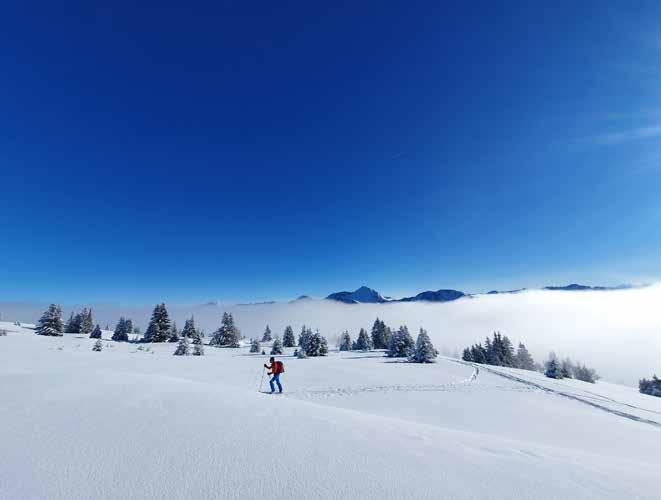
MOUNTAIN PLANET 2024 60
LES AILLONS-MARGÉRIAZ
The Massif Committee supports village resorts, the first impacted by climate change, as shown here in Aillons-Margeriaz, in the Bauges massif.
FOCUS
THE AVENIR MONTAGNE FUND IN PRACTICE:
Promoting the diversification of the tourist offer to reach new clients
THE FIGURES
82 OPERATIONS SUPPORTED, 74€M IN TOTAL INVESTMENTS WITH 18€M IN STATE CO-FINANCING.
The examples: Super Sauze zip line, Selonnet leisure base, Colmars-les-Alpes aquatic playground, Orres experiential hub, Saint-Ours via ferrata, Gréolières-les-Neiges all-season sled, Grandes Roches third-party tourist venues, Raphaël Poiré biathlon stadium requalification, cave bear museum requalification, La Plagne bobsleigh track panoramic room renovation, Matheysine Prairie de la Rencontre redevelopment.
ACCELERATING THE ECOLOGICAL TRANSITION OF MOUNTAIN TOURIST ACTIVITIES
THE FIGURES
41 operations supported, 68€M in total investments including 13€M in state co-financing.
The examples: Izoard pass landscape redevelopment, Isola ski slope renaturation, Molière-Sornin sensitive natural area access requalification, Bourne river trail Himalayan bridge, Chartreuse National Park and Cœur de Chartreuse tourist office joint house, Charmant Som access trail restoration, Bourg-Saint-Maurice funicular modernization, Glières plateau memorial trails requalification.
BOOSTING LEISURE REAL ESTATE AND CURBING THE OCCURRENCE OF EMPTY BEDS
THE FIGURES
24 operations supported, 30€M in total investments with 7€M in state co-financing.
The examples: Lac du Pavé refuge reconstruction, Montbrun-les-Bains thermal baths renovation, Le Fioc building renovation housing for seasonal workers at Les Deux-Alpes, Le Vercors holiday center renovation. These state credits were supplemented by the Auvergne-Rhône-Alpes and Provence-Côte d’Azur regions.

MOUNTAIN PLANET 2024 61
EVENT
WINTER OLYMPIC GAMES HEADING TOWARDS 2030
BY VÉRONIQUE PILON
Since November 2023, France has been the sole contender to host the Winter Olympics in 2030. The IOC has only retained the French bid, sidelining the Swiss and Swedish bids which were outpaced in less than six months by an efficient and determined team uniting the Auvergne Rhône Alpes and Provence Alpes Côte d’Azur regions. A crowning achievement that remains to be confirmed, as the project enters a phase of “targeted dialogue,” meaning that France’s bid is the only one in the final round, before an official awarding of the Games in the summer of 2024. After Chamonix, Grenoble, and Albertville, nothing seems to want to hinder the sporting momentum that will lead to the French Alps in 2030, with the ambition of hosting the first ‘winter games of the future,’ which are economical and environmentally responsible.
WINTER OLYMPICS 2030
GUIDING PRINCIPLES AND HIGHLIGHTS
I. The Winter Olympic and Paralympic Games: bridging two territories at the heart of the French Alps.
The two regions of Auvergne-Rhône-Alpes and Provence-Alpes-Côte d’Azur boast undeniable strengths: some of the world’s most beautiful and extensive ski areas, a deeply rooted sports culture, an unmatched density and quality of facilities,
II. and complementary expertise and strong guarantees.
For the first time in France, two regions are joining

David Lappartient (President of the French National Olympic and Sports Committee), Marie-Amélie Le Fur (President of the French Paralympic and Sports Committee), and Laurent Wauquiez (President of the Auvergne-Rhône-Alpes Regional Council) during the presentation of the Alps’ bid for the 2030 Winter Games.
forces for a single bid to optimize costs, efficiency, and environmental impact, offering a unique experience for athletes and spectators.
III. The organization of safe, economical, and responsible Games
95% of the sites planned for the 2030 Games already exist, notably a legacy from the Albertville ‘92 Olympics. A major asset for the French Alps’ bid, which is betting on an environmentally responsible event! The reuse of modern and existing infrastructure—whether for sports, tourism, or transport—will limit new constructions as well as costs, in line with the intention that “the Games finance the Games,” aiming to fund them primarily through private revenue generated by sponsoring partners, ticket sales, etc.
IV. An innovative approach in the dynamics of the Paris 2024 Games, with a lasting legacy as many as possible.
Some infrastructures or developments will have to be made, but always with the aim of organizing sustainable Games, leaving a lasting and useful legacy for the regions.
V. Responsible Games that take into account the challenges of climate change and accelerate the evolution of the regions and mountain sports in general.
These Games represent a tremendous opportunity to accelerate the transition towards a more sustainable mountain, with the intention of initiating a number of profound transformations.
MOUNTAIN PLANET 2024 62
KMSP

FOUR GEOGRAPHICAL HUBS

LAND OF GAMES
France has hosted the Winter Olympics three times Chamonix (1924), Grenoble (1968), and Albertville (1992) As well as three editions of the Summer Olympics including the upcoming Paris 2024, after those of 1900 and 1924 which were already held in Paris.

• Savoie Hub: alpine skiing (Olympic and Paralympic), ski jumping, Nordic combined, bobsleigh, skeleton, and luge

• Briançon Hub: freestyle skiing (Olympic and Paralympic), snowboard cross (Olympic), para banked slalom

• Haute-Savoie Hub: biathlon (Olympic and Paralympic) and cross-country skiing (Olympic and Paralympic)

• Nice Côte d’Azur Hub: ice hockey (Olympic and Paralympic), figure skating, short track, curling (Olympic and Paralympic), ski & snowboard cross (Olympic).

MOUNTAIN PLANET 2024 63 DR 1X EVENT
EVENT
FLASHBACK
ALBERTVILLE OLYMPICS - 32 YEARS LATER…
THREE QUESTIONS FOR…
Ludovic Bertagnolo,
Director of the Albertville Tourist Office and the Albertville and Savoie Olympic Games Centre
What legacy have the Albertville Olympics left?
The Olympics have been an incredibly strong influence in our region. They allowed the city to break out of its isolation and gain 20 to 25 years in development, whether it be in territorial planning, communication, or—especially sports facilities. They led to an explosion of tourist activity in the resorts, and Albertville was able to showcase its gems, like the medieval city of Conflans. They sparked dynamism in both the economy and tourism!
Tangibly, Albertville is a town of less than 20,000 inhabitants, yet it has services that are typically found in a city of 50,000 inhabitants. The infrastructure is still standing, maintained, and improved, and the services have become part of the daily life of the inhabitants. Here, the presence of the Olympics is omnipresent.
The Albertville Games, an inspiring model?
We have received several foreign delegations, especially from Asia, who come to see how our infrastructure has evolved. The organization of the ‘92 Games was exemplary in its reflection on the sustainability of the facilities, intended from the start to promote sports among locals and visitors, foster the emergence of athletes, and energize the territory. This is clearly what happened with the Olympic Hall, which, after two phases of renovation/extension, today hosts shows, business events, and very large-scale sporting events. The La Plagne bobsleigh track and the Courchevel ski jump are also doing very well and will be reused during the 2030 Winter Olympics.
The 2030 Winter Olympics, a new impetus?
That’s exactly how it’s perceived; the reputation of the Alpine destinations is well established, but regardless, hosting the Olympics is fantastic, it’s an incredible boost for the development of the regions. In the Alps’ bid, the concept of sustainability is at the forefront. These Olympics are envisioned as a driver for developing soft mobility and sustainability at large, which is a real challenge in our mountain territories.

The reputation of the Alpine destinations is well established, but hosting the Olympics is fantastic, it’s always an incredible boost for development
ALBERTVILLE 1992 IN NUMBERS
President: Michel Barnier
Co-president: Jean-Claude Killy
2 billion viewers
1,801 athletes from 64 nations
57 events - 3 events made their debut: Freestyle skiing, short track speed skating, and women’s biathlon
France: Ranked 7th among the nations represented with 9 medals, including 3 gold (Edgar Grospiron in mogul skiing, Fabrice Guy in Nordic combined, and the women’s biathlon relay), 5 silver (Sylvain Guillaume in Nordic combined, The Duchesnay in figure skating, Franck Piccard and Carole Merle in alpine skiing, Olivier Allamand in mogul skiing), 1 bronze, Florence Masnada in alpine skiing.
MOUNTAIN PLANET 2024 64
MANON GALIBERT
The Olympic Hall in Albertville: sports and cultural facilities
C’est transformer son expérience pour innover AIMER LE FUTUR
Colas








Retrouvez les acteurs du développement économique de la montagne Grenoble Alpes au salon Moutain Planet, stand N° 702.

#pionnier
Guilbaut
Champion du monde de ski de bosses Co-inventeur de l’Activebase
GRENOBLE ALPES Chamrousse
Grenoble Alpes janv. 2024 Atelier Duo www.atelierduo-studio.com
Crédit photo : Tristan Lebeschu
2030 Paralympic Games A Springboard towards More Accessibility
“For winter Paralympic sports, these Games would be a new fundamental step in their development, which is still in its infancy. For Alpine resorts, they would be a tremendous incentive to open their activities even more to all audiences and to strengthen accessibility.”
Marie-Amélie Le Fur, President of the French Paralympic and Sports Committee
OPINION
Christian Fémy
Director of Winter Sports at the French Handisport Federation
“I see all that the Paris 2024 Games bring in terms of accessibility, and I hope that with the 2030 Games it will give an additional boost, especially in terms of welcoming visitors to ski centers. We have needs and there are significant shortcomings. As part of the Olympics, of course, everything will be organized and arranged on the two concerned sites, Le Grand Bornand and Méribel, but what we hope is that the surrounding stations will realize that they need to accommodate audiences with disabilities. There has already been a lot of changes going in this direction, but in the context of the Games, this should raise even more awareness towards this audience.
Disability is not only about people in wheelchairs, it’s important to remember that it includes less visible disabilities, such as visual impairments or amputees, but also other types of audiences like obese people. We need to broaden the concept of disability, and I am convinced that the awareness raised by the Games will include all these people, whom we will consider in the equipment, organization, ski lifts, and support.
The Games will also inspire dreams and create new vocations, for sure! What we really lack are structured clubs, mainly because of the level of skills and demands required by the practice. I don’t expect solely the handisport clubs to get involved in the development of the practice, but the entire environment, clubs, resorts, ski schools. The consideration of disabilities needs to become more natural, it should be natural!”
“What we really lack in winter handisports are structured clubs, mainly because of the level of skills and demands required by the practice.”
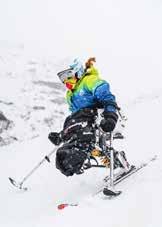
HANDISPORT AND ADAPTED SPORT WHAT’S THE DIFFERENCE?
Handisports are aimed at people with physical or sensory disabilities (visual or hearing). The French Handisport Federation supports these athletes in 28 different sports at the national level, including 15 that are part of the Paralympic Games program. For the Winter Games, the represented sports are cross-country skiing, biathlon, curling, ice hockey, alpine skiing, and snowboarding. Depending on the disciplines and disabilities, several podiums are organized. In skiing, for example, there are three podiums for seated skiers, standing skiers, and visually impaired skiers, with the performance of each competitor being weighted by a coefficient depending on their category of disability.
Adapted sports are aimed at people with mental and/or psychological disabilities. This sport suffers from a significant deficit in representation and recognition, which explains, among other things, why the general public tends to associate disability only with handisport. Yet, the FFSA (French Federation of Adapted Sports) today has more than 65,000 licensees, making it the largest federation of athletes with disabilities in France. At the Olympic level, only three adapted sports are represented at the Summer Games: athletics, swimming, and table tennis.
MOUNTAIN PLANET 2024 66
LILIAN MÉNÉTRIER
EVENT
INTERVIEW
Laurent Wauquiez, president of the Auvergne-Rhône-Alpes region
“These Olympic Games are an opportunity to showcase the new face of tomorrow’s mountains”
INTERVIEWED BY MARIE-FRANCE SARRAZIN

Laurent Wauquiez, president of the Auvergne-Rhône-Alpes Region, fought for the 2030 Winter Olympics to be held in the French Alps.
Why bid for the 2030 Winter Olympics?
“This project has been on my mind for a long time. We all have emotions tied to the Albertville Games. Some were volunteers, others spectators or athletes. Those are quite magical memories.
For 2030, everyone said, ‘We’ll never make it, it’s not possible, it won’t go through. There are the Americans, the Japanese, the Canadians, the Swedes, and then the Swiss...’ But still, I was itching to do it.
The Albertville Games were extraordinary for our territory’s development. I felt it was our duty to pass on the torch. And we also have to defend our mountains! There was a breakthrough. The stars aligned: the Japanese were no longer in the race, the Canadians weren’t there, Salt Lake City was postponed. We said: let’s go for it!”
You aim to organize the first sustainable Olympics. How will this be implemented in practice?
“Our primary goal is indeed to host sustainable Games. For example, we plan to create valley lifts to reduce car traffic. We will also develop hydrogen equipment with zero CO2 emissions. We want to work on thermal insulation as well... This is an opportunity to showcase the new face of tomorrow’s mountains. That’s what interests us.
The second focus is to propose frugal Games; and indeed, when we talk about 1.5 billion euros, it’s not 1.5 billion of public money. The goal is for the Games
to finance themselves. The advantage of having all the investments from 1992 means we can limit major infrastructure. For example, a bobsleigh track costs 160 million euros! We already have one.”
What will be the legacy of these Games in terms of infrastructure, and how can they contribute to the transition of these mountain territories?
“The French Alps’ candidacy is designed sustainably. Twelve of the thirteen infrastructures built for the Albertville Games are still usable today. They will be reused for the 2030 Winter Olympics and Paralympics. The French Alps also have a decarbonized transport network, with a continuum between rail and public transport. These modes of transport will be preferred during the event.
Also, these Games are a great opportunity to accelerate the transition to a more sustainable mountain, with the potential to initiate several transformations, such as the energy transition of snow groomers to hydrogen. These goals are as ambitious as they are necessary. Driven by the logic of proposing more sustainable Games, the choice of frugal Games was evident. Reusing modern and existing infrastructures—whether they are sports, tourism, or transport—allows us to limit new constructions and thus, consequently, limit costs, in line with the intention for the Games to finance themselves. Given the aim to organize sustainable Games, the necessary developments must meet the needs expressed by the residents of these areas so that the legacy of these Games is beneficial to the territory.”
MOUNTAIN PLANET 2024 67
EVENT
RÉGION AUVERGNE-RHÔNE-ALPES
WHAT WILL BE THE MOUNTAIN JOBS IN 10 YEARS?
An idyllic setting, a healthy and peaceful environment, a multitude of activities... On paper, mountains have everything to continue to inspire dreams. But today, attracting and especially retaining talent is often a challenge for mountain stakeholders. In the midst of transformation, the model must adapt to the arrival of Generation Z, the omnipresence of digital technology, new ways of consuming tourism, as well as ecological and sociological upheavals. Let’s take a deep dive.

MOUNTAIN PLANET 2024 68 DR SURVEY
PAR VÉRONIQUE PILON
GENERATION Z: WE WANT YOU!
“GenZ”, i.e., young people born after 1995, will represent about half of the company workforce by 2025. Regarding their approach to work, what distinguishes this generation? During a panel discussion on “The new generation and their relationship to work” at the “Sharing for the future” event in January, Emmanuel Abord de Chatillon, Professor of Human Resources Management at Grenoble IAE, listed the preconceptions: “Young people no longer want to commit”, “They want to devote time to important causes”, “They do not accept hierarchy...”
Perception or reality?
• PRECONCEIVED IDEAS
“I am against the principle of generations, especially in the company,” continued Professor Abord de Chatillon. “For me, these are clichés that deny progressiveness, are based on biased management and the idea of ‘it was better before’. Our model has evolved. Today everything is precarious, we perceive it differently.”
Whether it’s a phenomenon of the times or of the generation, it does not change the fact that young people entering the job market have a strong personality from which we should rather benefit.
During the same panel discussion, Géraldine Bonin, HR Manager at JL Events, responded to the topic: “Young people have lots of ideas, the precarious aspect and the unknown do not scare them. They bring their agility, their versatility. However, they are not closed to a framework, a process, a support.”

GENERATION COVID
Nico Didry, Lecturer and Researcher in charge of the Master SEST, notes that students are aware of the different pace imposed by tourism jobs, but are not ready for all the sacrifices. “Their priorities are different, the personal life aspect is very important. Covid has impacted them, in terms of fatigue, anxiety, but also life plans. They couldn’t do what they wanted, go abroad... They are less rushed to find a job, sometimes they take a break after their studies.”
• THE RIGHT APPROACH
Listening, dialogue, and flexibility are essential to attract these young talents. “It’s essential to listen to the new generations. Afterwards, we see what we can do,” observes Aymerick Bonnot, founder Ascensoof a mountain-specialized recruitment agency. “We can move the lines! We still try to hire people who fit into the boxes, but change will impose itself.” He adds: “We especially need to reach out to those who do not apply and understand why.”
“We can move the lines!” Aymerick Bonnot, founder ofAscenso
JOB DATING
MOUNTAIN PLANET INNOVATES
WITH JOB DATING.
SEE YOU ON THURSDAY APRIL 18, FROM 12:00 TO 17:00.

MOUNTAIN PLANET 2024 69 DR
SURVEY
Round Table during the “Sharing for the Future” exchange day hosted by Gwenaëlle Valentin of Cluster Montagne, with Emmanuel Abord de Chatillon, Géraldine Bonin, and Fabrice Bouttet.

2024 70 KYLE-JOHNSON
Employer Branding: Operation Seduction
In the mountains, the attractiveness of positions is sometimes dimmed by issues of accommodation and seasonality, but also by a lack of awareness of the richness and diversity of the professions.
• STORYTELLING
For Aymerick Bonnot, manager of Ascenso, there’s a major change in mountain recruitment. “We can no longer adapt positions based on locals. Today there are far too many specializations, we need to go find people where they are. Regarding attractiveness, there’s the issue of seasonal work, so there’s something to be said on the story we offer to seasonal workers. For permanent staff, it’s even more complex because they have to come and settle in the area and the prices are sometimes unaffordable. We propose a family life on site but the reality on the terrain does not allow it. Recruitment is very complex.”
Fabrice Bouttet, General Manager of SATA Group, spoke during the “Sharing for the future” panel discussion about how younger generations approach work: “At the beginning of my career, we thanked the company for hiring us, today we thank the employee for joining us. Our job is to develop mountain territories, to make it a long-term project for our collaborators. But how to sell them this dream? We sell a life project, including off-season, with depth, but also a vision of evolution. We sell our commitments, like sustainable development, housing, salaries, we work on all this as well. Out of 1100 employees we have 750 seasonal workers, the challenge is to keep them loyal, to have a permanent link with them.”
“We have a significant challenge in bringing value to our professions,” notes Gwenaëlle Valentin, MemberPartners/Employment-Training Manager at Cluster Montagne. “Recruitment problems are exacerbated because the public, especially young people, do not necessarily know mountain tourism development sectors. That’s why the last half day of the Mountain Planet trade show is dedicated to employment, to inform and create a connection.”
We have a significant challenge in bringing value to our professions
Gwenaëlle Valentin, Cluster Montagne
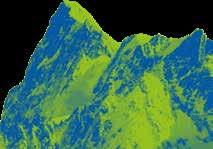
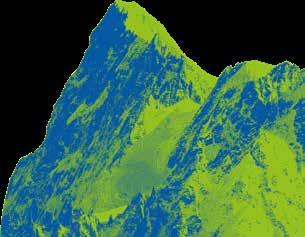
MOUNTAIN PLANET 2024 71
PROPOS RECUEILLIS PAR VÉRONIQUE PILON
SURVEY
Tomorrow, New Careers in the Mountains?
The evolution of technologies, new forms of tourism, and climate change are transforming the mountain world and its careers. The guiding principle? Ask introspective questions, adapt, innovate. New careers are emerging, or rather existing profiles are reinventing themselves.
• A Constantly Evolving World
Asked about the “new careers in the mountains,” Laurent Reynaud, General Delegate of Domaines Skiables de France, clarifies: “Firstly, new forms of tourism lead to an evolution of careers, whether because of customer expectations, the products we offer them, or internal questions, like the evolution of technologies and methods. There are careers emerging in connection with new tourist offerings. We have just signed a method agreement with employee unions of the ski lift sector to enrich the classification of careers in our collective agreement. It will include careers such as leisure vehicle operator, supervisor, animator for play areas... Mountain biking, which was not in our agreement, is making its entrance. Entering the sector’s directory involves a whole process of qualification and professionalization which itself is in perpetual evolution.”
• Teamwork
“We are in constant adaptation with a council of improvement that meets once a year and in which there are players from the sector. It’s the least we can do for professional training,” states Nico Didry, head of the Master SEST (Economic Strategies in Sport and Tourism). Gwenaëlle Valentin confirms: “In Cluster Montagne, we aim to strengthen the connection between universities and schools, we ask managers about their human resource needs and make the connection to create a bridge. It’s not always on this that Clusters show their value, but everything starts from there!”

The new forms of tourism first bring an evolution of careers
Laurent Reynaud, General Delegate, Domaines Skiables de France
MOUNTAIN PLANET 2024 72
THÉO MEUZARD & ROMAIN LAURENT
SURVEY
The Only Way is Digital
Even if the mountain has careers of the future, they are not clearly defined, yet all actors agree on one point: digital technology is making its way into all professions and is bringing forth new ones.
“Digitalization is everywhere today,” notes Laurent Reynaud of DSF. Ski lift operators have digital reporting tools that they have developed on their own or adapted. Maintenance has always been our profession, but it’s a new way of operating, with new tools.”
Aymerick Bonnot, leader of Ascenso, confirms: “Every position is increasingly moving towards digital and requires upskilling in that area. We also talk a lot about data, which brings new careers. In some organizations like Tourist Offices, there have been a lot of evolutions in digital positions. Where before, one person took care of the internet, now there’s a digital marketer, a webmaster, a community manager... There are more and more specializations in digital.”
“The professions within the Cluster Montagne are numerous,” explains Gwenaëlle Valentin, “At the last census, we were at 140 different professions. Saying what these professions will be in 10 years is quite complicated. What I have been able to validate is that the skills we will need the most are related to software development, artificial intelligence, applications, nondestructive preventive control, data interpretation, employee safety, with drone pilots for example. The challenges in the mountains are the same as elsewhere: data is everywhere and will be at the heart of many new professions with positions like data analyst or data scientist...”

Data is everywhere and will be at the heart of many new professions
MOUNTAIN PLANET 2024 73
IGOR-OMILAEV
SURVEY
In Search of Meaning
Even though it’s not a new concept, Corporate Social Responsibility (CSR) is now in the spotlight. Companies are increasingly allocating material and human resources to it and making it known! The human and environmental aspects are now an integral part of the company’s image.
CSR is the criterion that has progressed the most in the past two years for a majority of engineering school students and graduates (58%).
61% of students and young graduates want to exercise a profession that has meaning for themselves, for society, and for the common good.
• As a Matter of Course
“The desire to give meaning to one’s position is not recent, we have been observing the phenomenon for a while,” specifies Nico Didry. “However, on the ecological aspect, we have integrated the reflection on environmental issues into all courses in a transversal manner for five years. This year’s new step was to create a CSR course. Whatever position the students will hold, these subjects will be present.”
“Today there’s a need for frugality, a need that we first imposed on ourselves through eco-commitments set up in 2020 for all ski lift operators in France. Scarcity—or rather less abundance—the price, or both, push stakeholders to move towards optimized and virtuous management, to innovate to find new solutions. This forces us to evolve our professions,” adds Laurent Reynaud, of Domaines Skiables de France.
At Courchevel, we hired someone specifically to take care of fauna and flora, that’s new. Aymerick Bonnot, leader of Ascenso.
• Shaping Tomorrow’s World
“At Courchevel, we hired someone specifically to take care of fauna and flora, that’s new. They are moving forward on environmental questions, with positions on energy, building management, and seasonal worker housing, it’s tangible!” shares Aymerick Bonnot, leader of Ascenso.
“The trend of collaborative platforms is well established. We also see the emergence of experts on the environment or natural risks. These expertises will be increasingly demanded even if they are not necessarily new professions,” concludes Gwenaëlle Valentin from Cluster Montagne.

MOUNTAIN PLANET 2024 74
SURVEY
(Toluna Harris interactive survey conducted among more than 10,000 students and young graduates for L’Etudiant and Epoka.)
ACCÉLÉRER
VOS PROJETS INNOVANTS




2023_Innovation_Book_CM.indd 1 05/03/2024 17:05:43
THE RISING POPULARITY OF VALLEY LIFTS
BY VÉRONIQUE PILON
Whether it’s called a gondola, cable car, aerial tramway, or funicular... each of these devices for transporting people and goods between the valley and the mountain resort is now promoted under the name of valley lift.
The Cremaillère Express (Poma) connects the town of Bagnères-de-Luchon to the Superbagnères plateau in less than 8 minutes.

MOUNTAIN PLANET 2024 76 TE GARONNE MONTAGNE.JP
FOCUS
In a video created for the 40th anniversary of the Mountain Planet trade show, Pierre Montaz, founder of Montaz Montino, said about the ski resort boom in the 70s: “The state decided to open up all mountain municipalities by road, which allowed people in all these villages to leave more easily, but if at that time we had opened up our villages by ropeway, whether it rained, winded, snowed, day or night, it worked! And it would have cost much less than the road!” Time has proven him right, as today ropeway connection projects are booming. Ingenious and virtuous projects that reinvent mobility and respond to tomorrow’s challenges, even if the accompanying regulations and financing sometimes represent a challenge.
Faster, higher, farther, but also greener and smarter, the term “valley lift” sometimes encompasses cable-drawn elevator lifts, funicular railways, gondolas, or aerial tramways. “The name is a bit misused,” says Xavier Gallot Lavallée, CEO of MND. It depends on what you want to include. It’s a mix of urban and tourist, whose models are being defined.”
POMA group describes valley lifts as “Devices interconnected with valley transportation, providing fast, easy, and enjoyable access to the mountains and can address other challenges such as daily commutes for locals, seasonal workers, or the transportation of materials.”
Even though the “concept” is popular, the model is not new. “The Arcs Express funicular railway has existed for more than 20 years, just like the Brides-les-Bains gondola, built for the 1992 Olympics. There are also some valley lifts in the Pyrenees that have been operating for years and are absolutely relevant,” notes Fabien Felli, President of POMA.

A mix of urban and tourist, whose models are being defined

MOUNTAIN PLANET 2024 77 FOCUS
3D Concept Valley Lift
Replacing cars but also creating connections that do not exist today.

IN TUNE WITH THE TIMES
Regardless of their form, valley lifts are virtuous mobility solutions that meet the challenges of tomorrow’s mountain. For three essential reasons:
• BY LINKING STATIONS AND THE PLAIN, THEY SUPPORT AN ECOSYSTEM ALL YEAR ROUND.
In Saint-Gervais, two such projects will be launched at the start of the summer: a trans-valley lift and a cable-drawn elevator lift, projects that complement each other to serve locals, tourists, and thermal spa visitors. “We are going to create mobility. The idea is to replace the car as much as possible but also to weave connections that don’t exist today, without polluting,” says Jean-Marc Peillex, Mayor of Saint-Gervais.
“It’s interesting to see what this type of project will bring,” continues Fabien Felli. “This link creates new activities and accommodations in the valley, enriching communities at the top and bottom, facilitating mobility for day-trippers, seasonal workers, and tourists. It’s a positive dynamic for everyone! For example, the Skyvall linking the village of Loudenvielle and the Peyragudes station led to the creation of a spa center that operates at full capacity.”
• THEY HELP DECONGEST
ROADS TO THE RESORTS AND OFFER A TRANSITION TO SOFTER, MULTIMODAL MOBILITY
Transportation is the primary source of pollution related to winter sports, with over 50% of a station’s CO2 emissions. Even if the number of cars “replaced” by ropeway transport is not always easy to quantify, since new mobility and new users are created, the idea is still to shake up habits and convert as many drivers as possible. “Tomorrow, one could leave from London, Paris, or Brussels and arrive ‘skis on feet’ at Saint-Gervais without taking a car, thanks to a network of shuttles that will complement the valley lift,” continues Mr. Peillex.
• A MOUNTAIN THAT LIVES ALL YEAR ROUND
Design, installation, usage formats... valley lifts are designed for shared use and energize territories. Designed for a mode of use similar to urban models, they serve local actors as well as vacationers, enhancing the attractiveness of the mountain in all seasons.
MOUNTAIN PLANET 2024 78
POMA.
FOCUS
The Valléen project in Saint-Gervais from Fayet. Its location, near the train station, will revitalize interest in real estate in this part of the city.
SOMETIMES CONTROVERSIAL PROJECTS
These ropeway transport modes can encounter reluctance or even resistance...
“We need to differentiate between urban ropeway transport and valley lifts, which are received by the population differently,” explains Xavier Gallot-Lavallée. “Urban ropeway transport faces the same type of opposition as the implementation of a tramway, for example, regarding noise, servitude, landscape, access... For valley transportation, the installation is often less problematic. It’s meant to serve a ski resort where there are other lifts that people are accustomed to seeing in their landscape; they are used to using this type of transport.”
Yet, even in the mountains, projects can sometimes provoke opposition. “Some people are concerned, especially because of the wire ropes passing close to their homes; I understand them. In Saint-Gervais, we were accommodating; we listened to all the remarks to take them into account as much as possible. For example, we removed towers and raised the line to 33 meters, meaning the sound and visual nuisances will be much less significant than with the initial project. There’s also a whole new anti-noise technology being implemented with Poma, which will be a first in France. We’ve pushed as far as we could,” explains Jean-Marc Peillex.

From the village of Allemond, the Eau d’Olle Express gondola lift (MND) transports skiers and pedestrians to the Oz-en-Oisans resort, and for those who wish, to Alpe d’Huez in 8 minutes compared to 20 by road today.
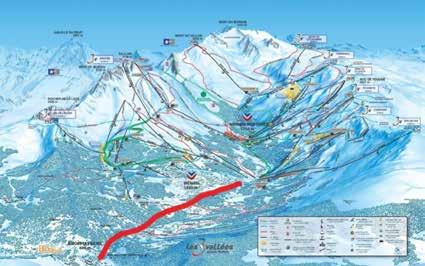
In red is the layout of the Olympe gondola lift, built in 1990 for the Albertville Winter Olympics. Since then, it has provided a link between BridesLes-Bains and Méribel-Centre, also serving small intermediate hamlets. It acts as a connection between the valley and the resort for skiers and pedestrians, essentially one of the first valley lifts.
MOUNTAIN PLANET 2024 79 DR FOCUS

A MODEL YET TO BE DEFINED
The economic model for these transport systems is often loss-making and faces negotiations between different stakeholders.
“Projects are increasing with a real will from local, departmental, and regional public authorities who wish to develop soft mobility,” explains Xavier Gallot-Lavallée. “But it’s not always easy. There’s a lot of investment aid to finance them, but discussions revolve around operating costs, disputed between public transport and tourist-oriented public transport... Several projects haven’t seen the light of day even though they were launched, due to a lack of agreements on financing the operation. There are more and more requests; projects will bloom, but in France, we haven’t yet found the economic miracle model. There’s no reason why we can’t find agreements to continue developing this type of installation, which makes complete sense from an economic or ecological viewpoint.”
“There’s a balance to be found between the operator and the community; on these connection projects, we realize it’s a win for all municipalities, at the bottom or top. We’re talking about resort access that benefits
a broad audience, not just tourists but also locals, seasonal workers. It’s an urban-type economic model, thus a public operation, which can vary depending on the resort operator type (DSP, private, direct management, SEM). There isn’t one answer, but several that adapt depending on the territory’s stakeholders and the number of impacted municipalities. Each project has its relevance, its economic model, and its funding rule,” specifies Fabien Felli.
In France, we haven’t yet found the miraculous economic model
MOUNTAIN PLANET 2024 80 P_DELOCHE010 RETOUCHE FOCUS
Inauguration of the thermal lift with Jena-Marc Peillex.
INDIA
FIRST SYMPOSIUM ON ROPEWAY TRANSPORT
The first Indian symposium on ropeway transport was held in New Delhi in February 2024. According to the website of SI Magazine (SeilBahnen International), urban ropeway transport is a strong trend in the country, as around 350 projects have been submitted for study by a stateowned infrastructure company. The purpose of this event was to bring together players in the field, from design to project execution.
During this symposium, the Indian Minister of Transport, Nitin Gadkari, emphasized “Made in India” and stated that ropeway transport would play a significant role in the growth of the Indian economy by developing safe, economical, and eco-friendly public transport solutions.
Many experts spoke at panel discussions on topics such as economical modes of transport, safety, and the development of public-private partnerships in India.
Compared to projects carried out in the Alps, implementing these “transvalley” projects presents many challenges in India. On one hand, they are intended to provide access to religious sites such as temples built on mountain tops or tombs hidden in caves, without altering these sites. On the other hand, the projects face restrictions, such as prohibitions on passing over military installations.
“These restrictions sometimes prevent us from conducting field analysis with drones, forcing us to carry out direct on-site studies for certain sections.
Another challenge is clearing the land to create the route of the line itself. The Indian Forest Department is very strict about permits, and the legislation in this regard is still vague,” explained Stephan Salzmann, CEO of Salzmann Ingenieure, to SI Magazine. The Indian Minister of Transport, Nitin Gadkari. Urban cable is a strong trend in India: 350 projects have thus been submitted for study by a state-owned infrastructure company.

The urban aerial ropeway is a strong trend in India: 350 projects have been submitted for study by a state-owned infrastructure company.
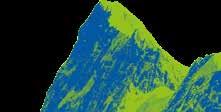
MOUNTAIN PLANET 2024 81 POMA FOCUS
Indian Transport Minister, Nitin Gadkari.
Remark-cable Projects!
POMA
ARCS EXPRESS FUNICULAR RAILWAY
An emblem of the valley for over 30 years, the Arcs Express, the funicular railway from Bourg-Saint-Maurice, is one of the first valley lifts in the Alps, renovated in 2019. A pioneer of multimodal travel, it offers skiers and daily users a direct connection between the Les Arcs ski area and the rail network in 7 minutes.

SAINT-GERVAIS
DR
THERMAL LIFT
Connecting the thermal park to the town of Saint-Gervais, this inclined lift is one of the only ones in the world to operate using the town’s wastewater. Set to start service in mid-2024.
SKYVALL GONDOLA LIFT
The Skyvall gondola lift connects the village of Loudenvielle to the Peyragudes ski resort. Starting in the summer of 2020, it has enhanced the four-season attractiveness of this beautiful Pyrenees valley and contributed to energizing and enriching the territory.

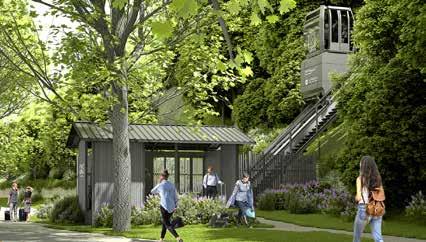
MOUNTAIN PLANET 2024 82 DR DR REMIND
FOCUS
Thermes Saint Gervais lift
MND
ESPIAUBE GONDOLA LIFT
A true meeting place between the foot of the slopes, the Col du Portet, and the summit of La Tourette, this 10-person gondola operates in both winter and summer.

Project carried out in collaboration with Bartholet Maschinenbau AG
OZ-EN-OISANS INCLINED LIFT:
A KEY LINK FOR THE HEART OF THE RESORT
This device, inaugurated in 2022, is the latest link in the valley lift connecting the village of Allemond and the center, responding to the challenges of soft mobilities in this mountain territory.

MOUNTAIN PLANET 2024 83 DR TICHODRONE
FOCUS
Mountain Water Reservoirs
A Topic of Debate in France, But Not Everywhere! So, is it good or bad to artificially contain water in the mountains?
BY VÉRONIQUE PILON
In February 2023, during his visit to the agricultural show, Emmanuel Macron stated that France must “continue to implement structures throughout the territory for mountain water reservoirs.” In the mountains, these reservoirs are a subject of debate because they are associated with the production of artificial snow and the «only-ski» model. However, even though their primary role is to produce this “white gold,” their construction is increasingly controlled and innovation for new uses is developing, including to diversify tourism.
Water is No Longer a Toy!
On the delicate subject of climate change and its impact on water availability, opinions are heated. “The issue creating tension is water, the oil of tomorrow,” observes Michaël Tessard, Director of SPL Domaines Skiables des Saisies. “These structures are assimilated with the ‘snow business,’ and the public is wary, but the topic is misunderstood. What a reservoir represents in terms of storage is nothing compared to, for example, filling swimming pools.”
“When we talk about water withdrawal, whether it’s for cooling a nuclear plant, churning water in a dam, or producing artificial snow, these are not real consumptions since the water is returned to natural environments,” emphasizes Laurent Reynaud, General Delegate of Domaines Skiables de France.
Why Withdraw and Store?
“We have narrow windows for snow production and need a very significant volume of water at a given moment. Direct withdrawal, from a river for example, would not allow us to have the same instant flows. Today, the rule is that in 100 hours of operation we must produce all the artificial snow for the season,”
Michaël Tessard, Director of SPL Domaines Skiables des Saisies.
WATER SHARING
• AGRICULTURE
70% of ski areas are grazing pastures. —
A cow consumes 100 liters of water per day. —
Water from reservoirs is fit for animal consumption.
“Of course, the reservoir is built primarily to produce snow,” continues Mickael Tessard. “But it’s common sense to seek to use it for other reasons. At Les Saisies, out of our four reservoirs, three are shared with farmers. We went further in 2021 by installing a lifting pump with a tank at the top of the mountain, which serves in winter for public toilets and in summer for farmers, including those who are at higher altitudes.”
Léna Durbecker, mission manager for Alpine Pastures at the Société d’Economie Alpestre—whose role is to sustain pastoral activity and support farmers’ projects—explains that in 2021 the SEA worked with Domaines Skiables de France in Haute-Savoie on a model agreement to regulate the sharing of water stored in mountain reservoirs. “It’s important that there are exchanges between ski area operators, farmers, and the municipality, the more we think ahead, the more the sharing is done in good intelligence, with a suitable technical aspect. It’s highly relevant for these reservoirs to be used by farmers, especially since they use a tiny part of the water during the summer.”
MOUNTAIN PLANET 2024 84
FOCUS

• AN EXTENSION OF USES
Today, reservoirs are sometimes designed for summer activities, such as fishing or even swimming with leisure activities, as is the case for the one in Praz-sur-Arly, inaugurated last season. Other uses can be related to fire safety or even drinking water with specific equipment.
Tomorrow, Innovating to Optimize?
Winner of the Cluster Montagne Innovation Prize, STEPSol, specialized in energy storage, is closely studying with snow farmers the deployment of microSTEP (Energy Transfer Pumping Stations) by reusing mountain reservoirs. The principle is to connect two basins of different altitudes by adding a suitably sized pump/turbine unit “In resorts, almost all the equipment is already there and is used only two months a year. Our innovation gives them a second, sustainable energy use,” explains Didier Pierrat-Agostini, president of STEPSol. The solution is in the potential study phase at Les Arcs, Les Saisies, and other resorts, and is ready to be deployed at Villard de Lans. stepsol-energy.com
VERY STRICT REGULATIONS
According to Laurent Reynaud, “We cannot simply say we need to withdraw less, we need to do it intelligently. The solution comes through regulations. What we do is not reckless, but under the control of the water police, with withdrawal authorizations issued by the Departmental Committees.”
What About Environmental Impact?
“We never have certainty that a project will come to fruition. Before building a reservoir, we conduct an impact study and if biodiversity is threatened, the project is rejected. Similarly, the structure cannot be built if there is no capacity to fill it! The State imposes working on alternative locations, but in all cases, we try to place the reservoir in a location that is naturally suited to it, to avoid having to alter the mountain,” explains Michaël Tessard.
Today, the issue is sensitive and projects are highly regulated. Stakeholders are looking for solutions to optimize the structures. It’s important to remember that on average on the slopes, snow is 10% artificial and 90% natural. One thing is for sure: the future solution for mountain tourism won’t just appear out of nowhere.
MOUNTAIN PLANET 2024 85 DR FOCUS
72 Obsolete Ski Lifts to Dismantle in France
As part of its eco-commitments, Domaines Skiables de France (DSF) and its members are dismantling abandoned ski lifts in French mountain ranges, in agreement with the mayors of the affected sites.
BY MARIE-FRANCE SARRAZIN
Some mountain territories still retain remnants of a past when a small ski lift brightened the leisure days of local residents and nearby vacationers. Over the years, these installations have become obsolete, and it would be incorrect to label these villages as ghost resorts, as they were never ski resorts in the strict sense.
Since the Mountain Law - Act II of 2016, the authorization of construction works comes with the obligation to dismantle ski lifts and their ancillary buildings and restore the sites within three years of their cessation. In any case, “all abandoned ski lifts fall within the scope of DSF’s action and will be dismantled eventually,” states the organization. Respecting the “landscape preservation” aspect of its eco-commitments, and to ensure that these structures no longer pose a risk to animals and people, DSF is committed to dismantling all 72 lifts identified across 44 French sites free of charge. Most of these are ski tows (only four are chairlifts). The Alps have 49, the Vosges 8, the Jura 6, the Massif Central 5, the Pyrenees 4, and Corsica none.
NEARLY ALL MACHINES RECYCLED
“Dozens of ski lifts are built, moved, or dismantled each year as part of the continuous improvement of ski areas in France. Over 20 years, the number of ski lifts has decreased by 17.8%, from 3,700 devices in 2010 to 3,040 in 2022, without reducing the number of ski runs. But here, we’re talking about something else: sometimes a ski tow stops, and no one is there to dismantle it.
That’s where we step in. This is the sixth time that development professionals have jointly and voluntarily contributed to returning a ski site to nature and pasture,” says DSF President Alexandre Maulin.
However, this is only possible at the initiative of the mayors of the concerned sites, after which a permit application is submitted to the prefecture.
Six dismantlements have already been carried out, and DSF plans to schedule three dismantlements per year. These operations are carried out by teams from nearby active ski area companies, “who voluntarily provide their logistical and technical support and collectively bear the necessary human and technical costs.” Considering that each dismantlement costs between 10,000 and 30,000 euros...
What happens to these machines? Almost all are recycled. If they are in good condition, they can be reused, or they may be acquired by a scrap dealer or repurposed for entirely different uses. For example, towers can be cut in half to secure cables or pipes under roads.

MOUNTAIN PLANET 2024 86
FOCUS
72 OBSOLETE DEVICES to dismantle have been identified across 44 French sites. 4 chairlifts and 68 ski tows.
THE ALPS HAVE
49 LIFTS TO DISMANTLE, the Vosges 8, the Jura 6, the Massif central 5, the Pyrénées 4 and Corsica 0.
THE THE NUMBER OF SKI LIFTS HAS DECREASED BY 17.8 %
IN 20 YEARS,
from 3,700 LIFTS IN 2010 TO 3,040 IN 2022, without reducing the number of ski runs.
10,000 À 30,000 €
the cost of each dismantlement.
6 DISMANTLEMENTS
have already been carried out since the beginning of the initiative, and DSF intends to schedule 3 dismantlements per year.

MOUNTAIN PLANET 2024 87 ALTERNATIVE MEDIA
FOCUS
KEY FIGURES
The dismantling is carried out by the teams of the nearby active ski area companies.
MOUNTAIN HABITAT & TRANSITION
THE TIME FOR RENOVATION OF MOUNTAIN RESIDENCES HAS COME
BY VÉRONIQUE PILON

MOUNTAIN PLANET 2024 88 DR
The issue of the obsolescence of many mountain residences and the fact that they were built for very occasional use, mainly related to skiing, has long been recognized. The result: overly systematic architecture, cramped apartments, decor that has aged poorly, poor insulation, energy-hungry equipment, and neglected common areas. Added to this is the lack of maintenance and follow-up, due to the fact that coowners rarely meet... To suggest innovative solutions, the Pôle Excellence Bois led the collaborative project Rénovacime with two architectural firms, Tectoniques and Tekhnê - Lieux Fauves in Lyon.
The study aims to be generic, offering adaptable solutions, with a constant concern for economic and operational realism. The project is based on a test building, the “Les Aravis” residence in Les Menuires. The objective: to rise to the challenge of an innovative and efficient renovation that adapts to evolving needs and the changing climate.
The project is therefore based on four axes of reflection to address strategic and ecological challenges, while also taking into account economic realities.
1. RENOVATION OF THE BUILDING ENVELOPE TO IMPROVE ENERGY PERFORMANCE AND AESTHETICS
The Rénovacime model aims for energy efficiency, the use of the wood sector and bio-sourced materials, as well as the solicitation of short supply chains and the use of local know-how. Wherever feasible, prioritizing the reuse of existing materials is preferred. Furthermore, the study extends to assessing the fate of outdated materials, aiming for at least 90% material reuse. Regarding energy performance, “We worked with the goal of creating a true quality thermal envelope, improving comfort both in summer and winter,” continues Sarah Viricel. The project aims to prioritize work on the insulated envelope and joinery, limiting work on technical systems. In an approach to carbon performance, the study opens up the possibility of implementing renewable energy production solutions in addition to the passive approach.
AESTHETICS: RESTORING LOCAL CHARACTER
While the architectural characteristics of these residences are often similar, the local contexts are very different. However, the trend is moving towards highlighting the uniqueness of each territory and its know-how. The Rénovacime project includes aesthetic work on the facade, valuing the use of wood, including in its structural role, and reintroducing a decorative dimension that takes into account local specificities and know-how.
2. IMPROVING COMFORT AND THE POSSIBLE EXPANSION OF HOUSING
The decision-making process in co-owned properties is tedious and complex. Few residences manage to carry out a comprehensive and unitary rehabilitation operation, especially when it comes to second homes! The device imagined in the Rénovacime project adapts to this reality, taking into account the different needs and means of co-owners. As an example, the optional balcony enclosure facilitates the expansion of interior living areas while providing access to ample outdoor space. Inside, the work is also «à la carte.» Practical, bright, and warm, the apartment is envisioned as a configurable and evolvable platform. “We designed the rehabilitation of the interior to make it more modular, with reflection on a variable number of occupants,” explains Ms. Viricel.
3. RECONFIGURING COMMON AREAS TO INTEGRATE NEW SERVICES
“If we want to change the use of these residences and accompany a transition in resort attendance, the common spaces can be an interesting vector. «They need to provide genuine usability and a sense of community,» emphasizes Ms. Viricel. In these obsolete residences, the lobby is non-existent or unused. The project aims to fluidify the link between the residential space and the outdoor spaces—the slopes, the meadow, or the street—especially important for summer or mid-season attendance.
MOUNTAIN PLANET 2024 89
MOUNTAIN HABITAT & TRANSITION


“We designed the rehabilitation of the interior to make it more modular, with reflection on a variable number of occupants”
4. CREATING NEW LIVING SPACES BY ADDING FLOORS
When refurbishing the roof, the idea is to incorporate a project for adding floors. This creation and sale of new private areas could potentially finance part of the project. Several options are proposed:
• A dozen exceptional new apartments on the roof to generate financial contributions to the co-ownership and redesign the silhouette of the residence;
• A rooftop designed to transform mountain co-ownership, adaptable to the changing seasons: it features a covered terrace with surrounding planter boxes, an enclosed and glassed section serving as a lounge, workshop, or wellness area, arrangements for a greenhouse or winter garden, and a play area...
• A leisure space under a closed hall, which could be carried by a third-party investor for its operation.
Hence, the “Les Aravis” building project includes a ground-floor lobby designed for relaxation or remote work. From the hall, a number of services are accessible to facilitate the occupants’ lives. Accessible via the common distribution and with a direct exit to the outside, spaces for lockers adapted to the needs of four-season outdoor practices have been imagined in place of old cellars.

Although based on a Research & Development project, all the solutions proposed in the Rénovacime project are adapted to reality and inspire a desire for renewal. In the coming decades, summer and mid-season tourism in the mountains is set to develop. Whether due to the increasingly extensive range of activities offered by resorts, climate trends predicting increasingly hot summers, or the development of new uses such as remote working or short weeks, resorts have everything to gain, and the accommodation offer will need to adapt and reinvent itself.
MOUNTAIN PLANET 2024 90 DR DR
Sarah Viricel associate architect at Tekhnê - Lieux Fauves architects.
MOUNTAIN HABITAT & TRANSITION
The “Les Aravis” demonstration building in Les Menuires, with its new facade.
A rooftop designed to adapt to new uses.



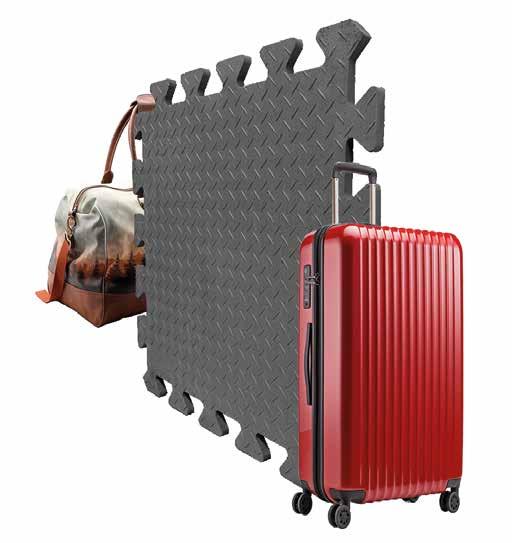
Fini les dalles caoutchouc qui voyagent aux quatre coins du globe avant de finir sous vos pieds. Notre dalle Ecoverclip® est produite à partir de bandages usés, préalablement collectés au sein des stations partenaires, puis recyclés en région Auvergne-Rhône-Alpes
Réduction de 50% des transports depuis l’Asie
120 tonnes de bandages qui évitent l’incinération
Scannez pour en savoir plus
What’s the Value of the Green Snowflake Label?
The allure of the mountains has never been greater. Record occupancy rates for the past two years, across all seasons, attest to this. So how do we reconcile sustainable development, the protection of increasingly sensitive areas, and the rising influx of tourists? This question has long been seized upon by the destinations involved. Now, they even have their rallying symbol: the Green Snowflake. Two little words that hide grand and very real achievements.
BY STÉPHANIE SCARINGELLA
“ The Green Snowflake is there to commend a territory’s commitment. It’s the recognition of its environmental ‘approach,’ explains Claire Tollis, Research & Development Manager at the Mountain Riders association. More than a ‘grade’ or a ‘number’ of satisfactory eco-friendly measures, it’s really the margin for progress and the sustainable dynamic that matter.” Often reduced to the simple status of a label (and therefore criteria to be checked off at a specific time), this qualification is therefore much more complex and interesting since it reflects a destination’s awareness and efforts to improve.
Sustainable Actions
Launched in 2011 by Mountain Riders—an association committed to assessing the mountain transition—and more than 70 independent entities including professionals, universities, climate-specialized organizations such as ADEME, the Foundation for Nature and Man, Earth of Solidarity Initiatives, and more, the Green Snowflake covers about 30 territories. “All have followed or are currently following the same path, namely an initial environmental diagnosis of the destination, then an entire year of in-person workshops,” continues the project manager within Mountain Riders.
These work and reflection sessions are common to all stakeholders (economic, tourist, political): the tourist office, the town hall, lift companies, the National Forestry Office, the natural park if there is one, accommodations providers, lessors, hoteliers, merchants...
From there, a solid action plan is established for the following three years. For the entire territory: the ski area
and the resort of course, but also pastoral and forest spaces. And, very importantly for us, for the inhabitants. The measures must not only concern the seasonal or tourist aspect, but also touch on ‘better living’ year-round.”
Widely present on the ground, Mountain Riders teams are unanimous: the changes initiated over the last decade are impressive. “These are not minor gestures. Mountain destinations are really rethinking and changing their models. We remain in regular contact with the territories, thanks to intermediate audits and our Edu-tours (seminars bringing together several destinations in one other’s territory for a couple days of exchange and presentations of actions undertaken on the ground, Ed.). The quantity of projects realized, experiments conducted are no longer anecdotal or specific cases. It’s a collective, massive awareness.”
Savoie and Haute-Savoie Stand Out
Today, of the 27 destinations honored by the Green Snowflake, Savoie and Haute-Savoie stand out: 11 resorts in Savoie (Les Belleville, Bourg-Saint-Maurice Les Arcs, Val Cenis, Saint François Longchamp, Tignes, Val d’Isère, Les Saisies, La Rosière, Valloire, Val Cenis, Crest-Voland Cohennoz) and 10 in HauteSavoie (Saint Gervais, Morzine-Avoriaz, Megève, Cordon, Chamonix-Mont Blanc Valley, Combloux, Châtel, Grand Bornand, Les Contamines-Montjoie, Passy). Similar characteristics are found: encouragement of soft mobility, valorization of waste sorting and recycling, sustainable development logic for the ski area, reflections on ecological housing, etc.
MOUNTAIN PLANET 2024 92
MOUNTAIN HABITAT & TRANSITION
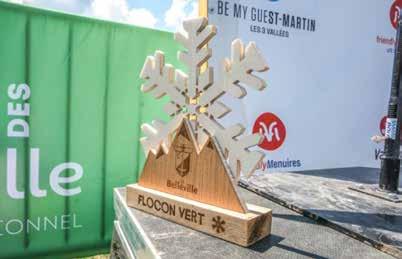
Locally, each station also promotes green initiatives. For example, the construction of a high-energyperformance chalet at the foot of a chairlift in Les Arcs, which has also committed to fighting plastic (since 2020) by installing water fountains in the ski area. The challenge was significant: nearly a million plastic bottles were consumed each year at the resort. The community of communes of Chamonix-Mont Blanc (Chamonix, Vallorcine, Les Houches, and Servoz) has made the fight against greenhouse gas emissions a core priority: free public transport within the resort
“These are not minor gestures. Mountain destinations are really rethinking and changing their models.”
Mountain Riders Association
and the “Via Cham” card—where locals, residents, seasonal workers, guests and students travel freely by train or bus throughout the valley. Photovoltaic panels are also installed in several refuges and it is the first mountain territory to join the Territorial Climate Energy Plan in 2012. In the same massif, Combloux stands out for its Four-Seasons diversification approach and, in particular, for the year-round efforts to offer a more eco-responsible life to its residents.
Meanwhile, the Châtel lift company has been ISO 14 0001 certified, which certifies an “environmental
management” aiming at reducing its ecological footprint. The resort has also transformed to allow skiers to join the two ski areas (Super-Châtel and Le Linga/ Pré-la-Joux) with skis on their feet.
Awarded the Green Snowflake last March, the destination of Saint François Longchamp produces more energy than it consumes thanks to its hydroelectric and solar energy production! And this station in the Maurienne Valley also stands out for its attention to people with disabilities.
In this non-exhaustive list, it’s impossible to overlook Tignes. The town hall has explicitly included its sustainable development will in its Local Urban Plan, going further than basic regulations. From now on, any new construction must use at least 80% renewable energy (photovoltaic or geothermal) and include a possible connection to a future heat network. As for extension permits, they are only granted in the case of thermal renovation included in the works.
Chamrousse, the Neighbor in Isère
In addition to its recurring “Clean Chamrousse” operations aimed at collecting waste in the mountains, the resort reiterates its successful ski equipment recycling operation —boots, pairs of skis, poles, helmets, etc.—among individuals, schools, and ski shops each year. Since then, the merchants who participated in the Trophy of the Peaks display the “Tri-Vallées” logo on their storefront to let the local tourists know about their approach.
The municipality of Chamrousse has also been heavily involved in the pastoral group. It is thus an actor in a new dialogue between shepherds, the ski area operator, and territorial authorities. The objective is to jointly manage the needs for pastoral developments to reconcile the preservation of local fauna and flora (including the protected species of the Black Grouse) with tourism attendance issues. “Chamrousse is also very dynamic in exploring new initiatives and experimentation,” emphasizes Claire Tollis. It’s a territory where collaborative and cross-disciplinary projects regularly emerge for more inclusion, more preservation. It’s one of those destinations that pulls the entire mountain community upwards.”
MOUNTAIN PLANET 2024 93 DR
MOUNTAIN HABITAT & TRANSITION
Precise Criteria
The association and 70 partner entities who are experts in tourism, sustainable development, and the mountains have defined more than 20 criteria, across 4 themes, for the award of this label of excellence. In terms of destination, firstly, territories must commit to: a four-season diversification strategy, adaptation to climate change (in summer and winter), and a reduction of their landscape footprint. The second sphere of assessment focuses on the economy: support for initiatives respectful of humans and nature, fair working conditions (career prospects, quality of seasonal worker wellbeing, consideration of disability), support for the local economy (agriculture and forestry, crafts, responsible public procurement). The third aspect examined: the social and cultural realm. The destination highlights and protects local heritage for both visitors and residents. This includes efforts towards education, raising visitor awareness of climate issues in the mountains, and adapted leisure activities for people with disabilities. The last criterion, the most substantial, obviously focuses on natural resources and reducing environmental risks: commitment to biodiversity and the respect of sensitive areas; adoption of a Responsible Energy strategy by developing local energies, public lighting regulation, and more; prioritization of soft mobility; the most virtuous management possible of drinking water, wastewater, and waste; and a crucial focus on the reasoned use of artificial snow.


MOUNTAIN PLANET 2024 94
TRANSITION
MOUNTAIN HABITAT &
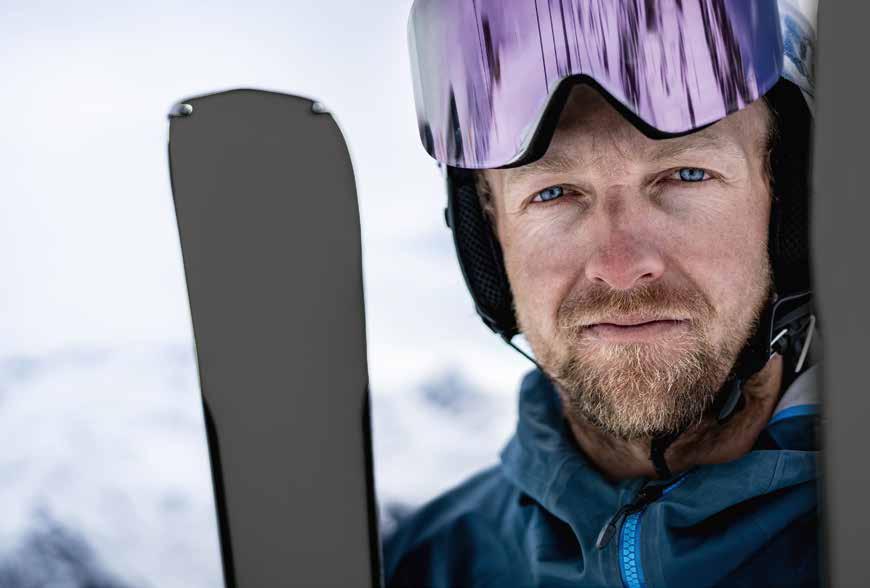
WORLD OF SPORTS
16.04. – 18.04.24, Grenoble
N° de l’allée : 10, N° de stand : 1041

Ski Service
Machines pour l‘entretien de skis et Snowboards

Location des Skis
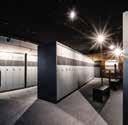
Consignes à Skis
De la conception à la réalisation
Founisseur de solutions innovantes
Easyrent et Easywork
Logiciels de location et de service Systèmes de stockage & séchage, Meubles de vente

Bike Services
Solutions pour le nettoyage des vélos

D’articles de sport, vêtements de travail et d’équipement de protection Solutions de séchage

En savoir plus : wintersteiger.com/sports
Can BIM Help Build Greener?
BIM (Building Information Modeling) is a set of processes based on the shared use of a building’s digital model and its functionalities. It facilitates exchange and interaction among all stakeholders in a building’s lifecycle: its design, construction, use, and even demolition. Given the crucial importance of environmental aspects in projects, how can the use of BIM contribute to building, renovating, or demolishing in a cleaner and more sustainable way?
BY VÉRONIQUE PILON

Innovating to Improve
Innovation involves processes and materials that are increasingly efficient. BIM allows for the simulation and comparison of different scenarios, especially in terms of energy performance. In this sense, it can contribute to more efficient and therefore more environmentally friendly constructions. However, this alone is not enough.
Optimizing Collaboration Among Project Participants
Many heads are better than one! The collaborative process of BIM leverages collective intelligence. When there’s a will to build sustainably, collaboration towards a common goal can be a real driving force. A global vision, especially an environmental one, and pooling of skills to aim for an ideal result is possible through this interactive tool.
Impact at All Life Cycle Stages
From design to renovation or demolition, BIM can support sustainable projects:
• DURING THE DESIGN PHASE, visualization allows for improved energy performance and the calculation of a building’s ecological footprint, thanks to the performance and traceability of all materials. This traceability enables control over the quality of the indoor environment, through the selection of healthy materials and design choices, such as for ventilation.
• DURING THE CONSTRUCTION PHASE, BIM facilitates environmental impact analysis, waste reduction, and improves overall site performance (not just in terms of efficiency but also in maintaining a «clean site»).
• DURING THE OPERATION PHASE, it helps monitor a building’s performance and offers management and maintenance capabilities that control various aspects like temperature and lighting.
• FOR RENOVATION OR DEMOLITION PHASES, if material and recycling information has been accurately recorded
MOUNTAIN PLANET 2024 96
BIM-MODELEUR
MOUNTAIN HABITAT & TRANSITION
from the start, BIM provides information for decarbonization, recycling, and even planning for the transfer and reuse of materials on other sites. The construction sector generates significant waste and CO2 emissions, and BIM is a powerful collaborative tool, including for managing the environmental impact of buildings. However, to be used to its full potential, it requires significant technical, financial, regulatory, and human frameworks. Its adoption by professionals is slow and elicits mixed reactions. France, far behind Germany or the UK in terms of BIM usage, is encouraging its use with initiatives like the BIM2022 plan, and progress is underway.
When there’s a will to build sustainably, collaboration towards a common goal can be a real driving force.

DID YOU KNOW ABOUT “CRADLE TO CRADLE”?
This approach defines and promotes the development of upcyclable products, meaning that, unlike conventional recycling, it maintains the quality of raw materials throughout the product’s life cycles and components.
Applied to the construction sector, this implies that in building construction, all components are selected and installed to generate no waste at the end of their life. They can be used on another site or recovered for reuse or reconditioning. But to effectively implement circular economy principles in construction, two prerequisites are necessary:
• Precise knowledge of the products and materials used,
• Planning for the building’s disassembly from the design stage.
This is the concept of the material bank building or circular building, to which Upcyclea is committed. This startup offers solutions to select the best products (through a library of circular passports), help you find reusable products and materials, and allow you to calculate the circular footprint of your projects based on the products and materials used.
www.upcyclea.com
MOUNTAIN PLANET 2024 97 DR
MOUNTAIN HABITAT & TRANSITION
The Slow Rise of Electric Mobility in the Mountains
Already innovative in solar energy with a unique photovoltaic solution integrated into ropeways, which earned it a ‘Green Product Award,’ Sunwind Energy has designed a solar electric charging station suited for mountain terrains and their specific challenges.
“The transition towards electric mobility is reaching the mountains, and some customers now choose their accommodation based on the availability of charging facilities.
The change is going to speed up quickly, and we need to be prepared,” explains Sunwind’s founder, Xavier Duport.
Specific Challenges in Mountain Areas
Ski resorts face significant fluctuations in electricity needs, with consumption peaks during the high season. Thus, it’s crucial to devise solutions to ensure that the new demand from electric vehicles doesn’t lead to saturation. Weather conditions, terrain peculiarities, and frequent changes in the layout of spaces within the resort also need consideration.
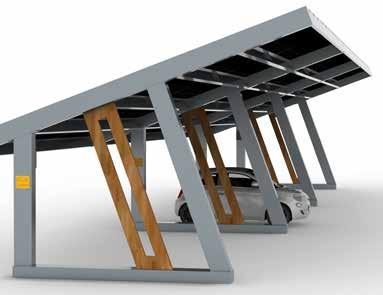
Technology Serving Ecology
Introduced at the latest “Mountain Planet” trade show, the E-Car carport by Sunwind Energy is designed specifically for mountain environments. Its metal structure’s volume is engineered to withstand wind and snow weight. Being self-supporting, it hardly requires any civil engineering work for installation and can be easily moved. With special treatment and new-generation dual-sided solar panels, it withstands temperatures ranging from -20°C to +70°C. Each Carport can generate power for two cars and can be installed in series, for example, in a parking lot. During offpeak periods, the generated energy can supply ancillary buildings or even produce surplus electricity to be sold. “Some hotels or residences are already equipped with charging stations, so the E-Car carport can supplement these stations,” says Xavier Duport. With electric cars capturing nearly 10% of the global automobile market, they are no longer confined to cities... mountain resorts now need to adapt.
MOUNTAIN PLANET 2024 98
MOUNTAIN HABITAT & TRANSITION
SUNWIND
PAR VÉRONIQUE PILON
PANORAMA
83%
of French people are willing to change their mobility habits to improve air quality and 82% to combat climate warming.
34% of French people currently have the ability to charge an electric vehicle (up 10 points from 2018).
46% of French people believe that the electric vehicle is the future of mobility (76% among 15-24 year-olds)
(Source: IPSOS France Study – November 2021)
11,683 public charging stations in the Auvergne Rhône Alpes region (out of 118,009 in France at the end of 2023, a 66% increase in one year).
Auvergne Rhône Alpes, the 2nd best-equipped region in France (after Ile de France).
(Source AVERE – April 2023)
TOTAL ELECTRIC VEHICLES
(cars, public transport, trucks, vans, motorcycles)
Haute-Savoie 7,165
Savoie 2,835
Isère 7,934
High average for these three departments
(Source AVERE – 2020 Study)
GETTING READY
AVERE Auvergne
Rhône-Alpes offers a free training program, ADVENIR FORMATIONS, for landlords, condominium trustees, and council members on electric mobility. Topics include current and upcoming regulations, implementation of charging stations in multi-unit dwellings, billing solutions, subsidies, etc.
Sessions last 1.5 to 2 hours, available inperson or remotely, for groups (minimum of 10 people). This program is led by AVERE France and funded by the Ministry of Ecological Transition through the EEC mechanism until the end of 2023.
Informations
Aurore Comte
06 14 22 15 34 KEY FIGURES
aurore.comte@avere-aura.fr

MOUNTAIN PLANET 2024 99 MOUNTAIN HABITAT & TRANSITION
What’s New in Real Estate Tech?
Research and Development, blockchain, Artificial Intelligence, specialized platforms, and dedicated clouds, virtual reality... French Tech is making its entrance into the real estate sector, shaping a new ecosystem. And this is for professionals as well as individuals alike. A non-exhaustive overview of some Proptech gems.
BY STÉPHANIE SCARINGELLA
Land Prospecting, Open Data, and Digital
The RE 2020 and the revision of Local Urban Plans (PLUs) have led to a record number of new building permits: more than 500,000 over the last 12 months. Yet, this is still not enough. With an annual decrease of 5%, the construction of multi-family housing is declining. As a result, France is short of 100,000 housing units per year. The control of land and its regulations, considering urban planning and environmental constraints, and the feasibility analysis of a real estate operation are therefore essential. Several companies are positioning themselves in this market.

PROMOLEAD REDEFINING LAND PROSPECTING
In 2015, land development specialists Amaury Paour and Nicolas Foucout created this Lyon-based startup, which develops a land CRM—available on Web and Mobile—including a land search module. PROMOLEAD offers real estate professionals a tool to manage their portfolio: from prospecting to the follow-up of land agreements. Developers can record all the stages of their project development in a secure space. Thanks to collaborative work, the company pools the skills of each individual to increase efficiency and, with data being secured, in the event of an employee leaving, the company is also able to retrieve their history. Moreover, PROMOLEAD offers a training service in land development, through various courses within the Qualiopi-certified Promoelad Academy, allowing agents and real estate traders to improve their skills. Among the clients: Bouygues Immobilier, Cogedim, Nexity; and local players like Priams, based in the Annecy region.

MOUNTAIN PLANET 2024 100
PROMOLEAD
PROMOLEAD
MOUNTAIN HABITAT & TRANSITION
Amaury Paour and Nicolas Foucout, founders of Promolead
KEL FONCIER
FIND LAND, CONTACT THE OWNERS
To fight against urban sprawl, KEL FONCIER invests in the collection, cross-referencing, and enrichment of land data since 2015. Its application integrates more than 50 search criteria such as cadastre, up-todate Local Urban Plans, points of interest by neighborhood, mobility, etc. and delivers, in one click, the buildable potential of any plot in France, its owner and contact details, as well as all regulatory, architectural, and environmental constraints. Thus, urban land becomes easier to identify for the developer building housing but also for those wishing to build offices, warehouses, supermarkets, schools, etc.

PROMY
REVEALING THE POTENTIAL OF HOUSES AND LAND
PROMY redefines the relationship between landowners and developers. With its one-stop shop that gathers 120 billion data points collected and secured in a private cloud—plot number, urban planning, environmental risks, etc.—the platform offers individuals a complete overview of their land for free. If Artificial Intelligence reveals a buildable potential, the property will be presented, via a marketplace, to their network of more than 300 developers.

“Building the city on the city is fighting against urban sprawl. New residents are better integrated, agricultural and natural spaces are preserved,” explain the startup founders. The performance was praised in 2021 as KEL Foncier received the Pass French Tech for hypergrowth company, as well as the “French Tech Gem” and Grand Prize “Technology and Real Estate Innovation” from L’AGEFI and the IEIF.
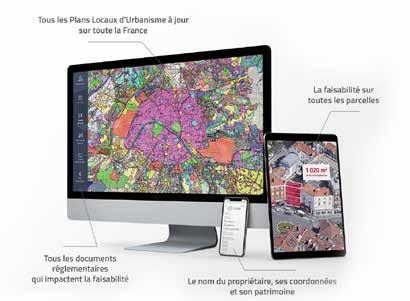


MOUNTAIN PLANET 2024 101
PROMY
& TRANSITION
MOUNTAIN HABITAT
Eduardo Larrain, CEO of Kelfoncier
Romain Solenne, president of Promy
HABITAT & TRANSITION
BUILDRZ
FROM LAND TO PERMIT, AI AT THE SERVICE OF PROJECTS

Helpful applications
Manuel Verrier, CEO de Buildrz
The goal of BUILDRZ? To remove obstacles to construction through digital technology, by analyzing all the parameters of a project before its construction, and to work towards the construction of greener new buildings, by integrating environmental and regulatory constraints from the start. The application promises, in 30 minutes, optimal feasibility to developers, architects, or local authorities. Concretely, via an interactive map, the project owner detects land plots with high construction potential. Then, thanks to AI, a unique technology (developed after five years of R&D) crosses thousands of data points in a few moments and creates a 3D model of 10 different construction scenarios, each perfectly compliant with the Local Urban Plan and integrating various energy indicators (ground cover, sunlight, carbon consumption, etc.). Having recently entered the market (2021), the company is carving out a prominent place in Europe, with a portfolio of more than 50 clients, even considering exporting its model to the United Kingdom.
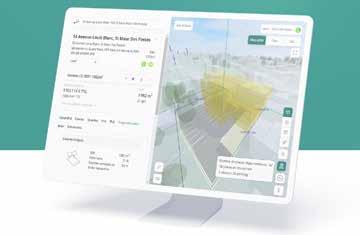
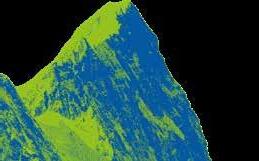
Digital innovation also takes hold of services. Whether it’s to share feedback, compare services, facilitate connections, etc., everything is now just a click away.
ECONHOMES
REDUCING BUILDING EXPENSES
Predictive, budget, tender management, contract implementation, expense reduction and monitoring... The startup ECONHOMES truly positions itself in the optimization of regular condominium expenses. By integrating into the ecosystem, Econhomes supports property managers by developing solutions to manage condominium expenses at all stages of a building’s life. The project is based on the meeting of tech and purchasing, through a unique database on the intrinsic condominium expenses. The company’s buyers rely on this data to propose improvement strategies and renegotiate contracts. A win-win perspective: for owners (substantial savings) and home-owner associations (ensured to provide sustainable and competitive solutions to their clients).

MOUNTAIN PLANET 2024 102 DR
MOUNTAIN
The two founders of econhomes, Corentin Le Moal and Pierre-Emmanuel
SAQARA SIMPLIFYING THE DAY-TO-DAY OF CONSTRUCTION

The same concern for fluidity is found at SAQARA, the hub that offers a digital solution specialized in the management of tenders (from launch to signature), for construction professionals. The AOS app allows different stakeholders to collaborate directly from the platform, in a single secure space where data is stored. Tender launchers use the app to control of budgets and schedules and service providers use it to enhance visibility by creating very detailed identity sheets that include the skills, achievements, amounts and types of work. The app also provides the possibility for monitoring. It is designed to facilitate the daily life of construction sector players.
IMMODVISOR THOUSANDS OF REAL ESTATE REVIEWS
Based on the well-known principle of sharing client reviews and with more than 20,000 references across the territory, IMMODVISOR allows, since 2014, to inform about the e-reputation of real estate and housing professionals. The community platform goes even further by regularly feeding news articles, advice, and tips. It’s genuine support for anyone wanting to buy, sell, rent, or lease a property. The strength of this startup is to consider the sector from a 360° perspective: real estate agency, agent, builder, developer, broker, property manager, but also building tradespeople, home staging, mover, diagnostician, etc. About twenty professions are represented in its pages, through feedback read and moderated by humans. From the start, IMMODVISOR also adhered to the standards of the Afnor Certifications, certifying respectful, verified, and justified comments (with proof of purchase by the internet user if needed).



MOUNTAIN PLANET 2024 103
Thomas Cassou with Alexandre Brochot, co-presidents of Saqara
Jean-Philippe Emeriau, founder of Immodvisor
MOUNTAIN HABITAT & TRANSITION
INDUSTRY
COCORICO !
The health crisis has brought the “Made in France” initiative back to the forefront of the French economic and societal landscape with three objectives in mind: job preservation, carbon footprint reduction, and national independence. The mountain development industry is no exception to this trend. Following the example of Poma, a strong advocate for Made in France, which employs 60% of its 1500 employees in the Auvergne Rhône Alpes region, three other players in the field are highlighting innovation and the know-how of the French Alps.
BY VÉRONIQUE PILON
MND
HOME SWEET HOME
With more than 3000 clients in 49 countries, MND proudly showcases its “Made in the Alps” label today. “We first repatriated our activities during Covid, then in 2022 there was a very strong rebound in activity that led us to start the construction of an extension,” says Xavier Gallot Lavallée, CEO of the company. Two ski lift manufacturing units and one snowmaking unit were repatriated from Italy, Germany, and Sweden, forcing the group to expand its industrial space, which now spans five hectares in the Alpespace area in Savoy.
• WIN-WIN
While relocation represents an initial investment to end an activity in one country and transfer it to another, the balance must be considered from all angles. “Overall, we believe it’s positive. Not only from an economic standpoint but also in terms of reducing our carbon footprint, particularly related to transport between our sites. It’s also a guarantee of quality and efficiency for our clients and for our teams who have everything on one site: design office, purchasing, production, logistics...” continues Xavier Gallot Lavallée.

A
• FRENCH EXPERTISE
As is the case with everyday consumer products, industries that promote French manufacturing are attracting more and more customers, including internationally. Mr. Gallot Lavallée states: “In our activities, France is globally recognized for the quality of its ski resort developments. Therefore, across the entire sector, which we are part of, ‘Made in France’ is a hallmark of excellence and innovation. As for our French clients, they are sensitive to this because it represents a reduction in environmental footprint, job preservation, and maintenance of links with local players, which is important.”

“Made in France” is a hallmark of excellence and innovation.
MOUNTAIN PLANET 2024 104
MND
5-hectare industrial site in Alpespace
IDM RECYCLE TO RELOCATE
Founded in May 1993 in Annecy, IDM specializes in spare parts for ski lifts and snow grooming machines. Since wear parts are primarily made of rubber, the company has become an expert in the material. “Gradually, we diversified into anti-slip floor coverings for ski lift stations or access ramps,” says Dominique Iaconantonio, Marketing Manager at IDM.
• VIRTUOUS CIRCLE
Driven by customer demand and the internal desire to evolve towards more responsible products, the company developed a recycling system for ski lift liners. “With partner ski resorts, we collect these liners (wear parts) to manufacture anti-slip floors. The raw material, rubber, is recycled in Rhône-Alpes, and the mats are also made in the region through co-investment with our industrial partner ‘Plymouth Française.’ In 2023, we reprocessed about 120 tonnes of liners that would have been incinerated. This represents a saving of 1200 tonnes of CO2 compared to rubber imported from Asia.”
While the organization is well-established today, there are still logistical challenges in collecting the rubber for recycling. However, ski resorts are keen on such initiatives, both willingly and out of necessity. “Every year, we send a summary to our clients specifying the volume of CO2 saved, the number of liners recycled, and the number of mats produced through this recycling. They can use it to highlight their ecological efforts.”
• PUSHING BOUNDARIES
Some products are challenging to manufacture in France because raw materials like natural rubber are impossible to find. However, the company strives to source within the European Union whenever possible. “The goal of IDM is to integrate as many recycled materials into its products as possible while ensuring that the end of life of products is handled responsibly, ideally through a circular economy project,” concludes Mr. Iaconantonio.


MOUNTAIN PLANET 2024 105
IDM
INDUSTRY
TONNES OF LINERS RECYCLED
2023 120
1200 tonnes of CO2 saved
The IDM slab is made of 75% recycled rubber and manufactured in the Auvergne-Rhône Alpes region
DUPON FIRST TRACK
Founded in 2009 in the heart of the Alps, AZTEC was acquired in 2016 by CM DUPON, the only French manufacturer of ice resurfacing machines.
In 2016, the company ventured into the production of snow groomers and released its first thermal machines. Romain DUPON, from the 3rd generation of a local industrial family, now leads a team of 20 people and has embarked on an ambitious project since 2020 in close collaboration with the Compagnie des Alpes: the electric snow groomer.
• A VANGUARD DUO
“We were already collaborating on other product ranges with the CDA, and there was a strong desire from its leaders to shift environmental standards. We knew that with current technologies, there was something to be done, and the Compagnie des Alpes embarked on this journey with us,” recounts Romain Dupon. After a first prototype last summer, the production of pre-series models was launched. Two machines were deployed this winter, and six more will follow next winter to gather data across all sites and refine the product. “The field experience represents a new phase of the project to tailor the snow groomers based on user feedback, which will further our progress. Each one will find a use for this type of motorization and bring their knowledge and experience. For example, some sites will prefer these snow groomers in areas where diesel supply is challenging, while other resorts will use them primarily at the front of the snow to avoid noise at night.”
• THE FUTURE BELONGS TO THE BOLD
“Compagnie des Alpes is making the financial, technical, human, and material effort to crash test, doing it for the market, as there is no exclusivity contract with them,” continues Romain Dupon. “We are grateful to have a client who understands that this is a ‘marathon’ project over several years. It was quite a gamble! Initially, aside from the Compagnie des Alpes and us, no one believed in it. Time has proven us right. We’re trying to maintain this lead. For now, we’re the only ones offering this type of motorization in this size, and we hope it will open up the international market for us.”
Currently, all Dupon products are manufactured in Pontcharra in Isère. The company is also an expert in renovating ice resurfacers and snow groomers. “It’s part of our commitment to giving machines a second life because environmentally, the less we have to manufacture, the better.”

EN CHIFFRES
69 % of leaders with most of their company’s activity based in France report an acceleration of their turnover linked to Made in France.
40 % of leaders claim to have already begun relocating their activities to France.
86 % of leaders believe that industrial relocation within the national territory could positively improve our economy.
32 % of business owners say they are using French suppliers more since the health crisis.

MOUNTAIN PLANET 2024 106 DR
Made in France, industrial relocation, where do we stand since the health crisis? Study conducted by Opinion Way for the agency Insign.fr Sample of 102 company leaders with 50 or more employees. Interviews conducted in 2021.
INDUSTRY
PERFORMANCE ULTIME EN TEMPÉRATURES MARGINALES
Design innovant et composants de haute technologie, pour une exploitation maximisée des plages de froid.

N ous vous proposo ns des technologies innovantes afin que vous tiriez le meilleur parti de vos équipement s et maximisiez votre production de neige, quel les ques so ient les condit io ns et notamment en températ ure s marginale s !

official product partner
INDUSTRY
POMA
SHOWCASE OF FRENCH INNOVATION
Deeply rooted in the RhôneAlpes region—where the group has its roots and where its four subsidiaries are located—Poma possesses an integrated mastery of the entire value chain, from operations to the management and maintenance of urban and tourist sites. Additionally, through a comprehensive collaborative approach, the company surrounds itself with the best in their field, favoring local partners such as Michelin, Arcelor, Thales, or Sunwind.
“We are very proud to be part of these dedicated French manufacturers, whether it’s in terms of quality control, our carbon
footprint which reflects on the overall operation, or our closeness to our clients, who are increasingly sensitive to the short supply chain,” says Fabien Felli, President of Poma.
• FRENCH KNOW-HOW HONORED
In March 2024, POMA was invited to participate in the exhibition of sports company products made in France during the event “Bercy se mobilise pour le sport” at the Ministry of the Economy, Finance, and Industrial and Digital Sovereignty. On this occasion, Bruno Lemaire expressed his support for the sports economy and highlighted French know-how and the dynamism of this industry.



MOUNTAIN PLANET 2024 108 DR DR
Fabien Felli, President of Poma.
The Poma factory in Gilly-sur-Isère, Savoie. This third French site employs 150 people.

21-23 AVRIL 2026
THE INTERNATIONAL MEETING PLACE FOR MOUNTAIN PROFESSIONALS
Since 1974, the Grenoble event park has organized and hosted, every two years, the largest international gathering of professionals from the mountain world. The diversity, representativeness, and quality of the exhibitors make this trade show a unique global crossroads, a place for business, exchanges, and an essential forecasting platform.
Mountain Planet 2026 will once again be the center of French and international ecosystems to address the future challenges of mountain development and rejuvenate its various sectors.
ALPEXPO SHAREHOLDERS



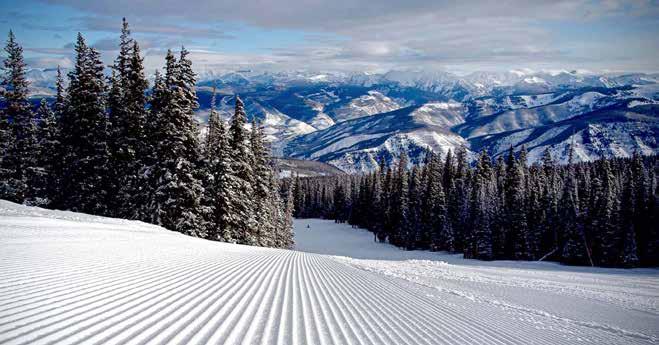
MEMBERS OF THE RESTRICTED COMMITTEE CO-CHAIRS
ALPEXPO – ANEM – DOMAINES SKIABLES DE FRANCE – ANMSM
MEMBERS
AFMONT – GRENOBLE CHAMBER OF COMMERCE – SAVOIE CHAMBER OF COMMERCE –CLUSTER MONTAGNE – AUVERGNE-RHÔNE-ALPES REGION – DOPPELMAYR – KASSBOHRER – LEITNER –MND – MONTAGNE LEADERS – POMA – TECHNOALPIN - FRENCH TECH IN THE ALPS

MOUNTAIN PLANET 2024 110 JON RESNICK
CLAP DE FIN
eBike®
Carport solaire pour VAE


SUNWIND ENERGY a mis au point une borne photovoltaïque innovante
Recharge directement en 220 V
Utilisable par les chargeurs de VAE
Autonome ou raccordée au réseau
Résistante aux intemperies
Jusqu’à 2500 m
Mise en place rapide Personalisable


Le partenaire de vos solutions durables et innovantes www.sunwind.fr contact@sunwind.fr




















































ma montagne, AUTREMENT plus responsable.
ma montagne, AUTREMENT plus responsable.

Pionnier du transport par câble, POMA engage LIFE R’way, une démarche innovante avec une sélection de produits à FAIBLE IMPACT ENVIRONNEMENTAL.
Pionnier du transport par câble, POMA engage LIFE R’way, une démarche innovante avec une sélection de produits à FAIBLE IMPACT ENVIRONNEMENTAL.
Dès aujourd’hui, imaginons ensemble une mobilité toujours plus durable, pour connecter les hommes et les territoires en harmonie avec notre environnement.
Dès aujourd’hui, imaginons ensemble une mobilité toujours plus durable, pour connecter les hommes et les territoires en harmonie avec notre environnement.



























































































































































































































































































































